01b4bbda9122fb64dc31c60444ce5374.ppt
- Количество слайдов: 196
 Teaching English as a Second or Foreign Language Speaking
Teaching English as a Second or Foreign Language Speaking
 Introduction • • • For communication. The most demanding, and the centre of the four skills. A variety of demand, such as monitoring, understanding, contributions thought, producing that contribution, and monitoring its effect.
Introduction • • • For communication. The most demanding, and the centre of the four skills. A variety of demand, such as monitoring, understanding, contributions thought, producing that contribution, and monitoring its effect.
 • Acquire the stress, rhythm, and intonation of English • It is almost always accomplished via interaction with at least one other speaker • Teaching of oral communication skills as a contextualized sociocultural activity has become the focal point in many ESL classroom.
• Acquire the stress, rhythm, and intonation of English • It is almost always accomplished via interaction with at least one other speaker • Teaching of oral communication skills as a contextualized sociocultural activity has become the focal point in many ESL classroom.
 Language comprises four dimensions as following • Grammatical competence including rules of phonology, orthography, vocabulary, word formation, and sentence formation. • Sociolinguistic competence expression and understanding of appropriate social meaning and grammatical form in different context. • Discourse competence how sentence elements are tied together via reference, repetition, synonym, etc. • Strategic competence A repertoire of compensatory strategies that help with a variety of communication difficulties.
Language comprises four dimensions as following • Grammatical competence including rules of phonology, orthography, vocabulary, word formation, and sentence formation. • Sociolinguistic competence expression and understanding of appropriate social meaning and grammatical form in different context. • Discourse competence how sentence elements are tied together via reference, repetition, synonym, etc. • Strategic competence A repertoire of compensatory strategies that help with a variety of communication difficulties.
 In the Speaking Class • Students should be allowed and encouraged to initiate communication. • when possible. • Determine the content of their response or contribution. • Evaluate their own production and learning progress.
In the Speaking Class • Students should be allowed and encouraged to initiate communication. • when possible. • Determine the content of their response or contribution. • Evaluate their own production and learning progress.
 The oral skills class • • • Class Aim Who are the students? Why are they there? What do they expect to learn? What am I expected to teach. One basic consideration is the level of the students, and their perceived needs.
The oral skills class • • • Class Aim Who are the students? Why are they there? What do they expect to learn? What am I expected to teach. One basic consideration is the level of the students, and their perceived needs.
 Four- point scale from poor to excellent confidence, pronunciation, social conversation, listening ability.
Four- point scale from poor to excellent confidence, pronunciation, social conversation, listening ability.
 How to enhance students’ skills: • Extensive authentic practice in class participation (taking part in discussions, interacting with peers and professors, and answering questions). • From life realistic. • Give, and request personal information. Directions, and price. • Talking family members; tell time; give, and accept compliments.
How to enhance students’ skills: • Extensive authentic practice in class participation (taking part in discussions, interacting with peers and professors, and answering questions). • From life realistic. • Give, and request personal information. Directions, and price. • Talking family members; tell time; give, and accept compliments.
 Conversation courses Emphasize • speech acts such as; greeting (congratulation, hi, hello), and apologizing (sorry, please forgive me. . )
Conversation courses Emphasize • speech acts such as; greeting (congratulation, hi, hello), and apologizing (sorry, please forgive me. . )
 Speaking Naturally • covering opining an closing a conversation, introducing and addressing people, giving invitations, expressing thanks, apologizing, complimenting, getting attention and interruption, agreeing and disagreeing, controlling the conversation, and getting information.
Speaking Naturally • covering opining an closing a conversation, introducing and addressing people, giving invitations, expressing thanks, apologizing, complimenting, getting attention and interruption, agreeing and disagreeing, controlling the conversation, and getting information.
 • Oral activitiesdiscussions, speeches, role plays, conversations, audiotape oral dialogue. Journals, and other accuracy base • Discussion. The most commonly use activity in the oral skills class. • Methodintroduce a topic, via reading or listening passage, or from videotape, then asked to get into pairs or groups to discuss, in order to come up with a solution, or response, or the like.
• Oral activitiesdiscussions, speeches, role plays, conversations, audiotape oral dialogue. Journals, and other accuracy base • Discussion. The most commonly use activity in the oral skills class. • Methodintroduce a topic, via reading or listening passage, or from videotape, then asked to get into pairs or groups to discuss, in order to come up with a solution, or response, or the like.
 • First, planned (versus random), the “right way” to group is necessary. • Second, to reach a good solution, each student should need a specific responsibility. • Third, clear about the reasons (what, and why), and what outcome expected.
• First, planned (versus random), the “right way” to group is necessary. • Second, to reach a good solution, each student should need a specific responsibility. • Third, clear about the reasons (what, and why), and what outcome expected.
 Speech-normal type • • • Prepare speech Provided by teacher Avoid boring in the class, making responsibilities during speeches, and listener. Summarize its content. Note strength, weaknesses, or relate the speech topic to a personal experiences. Videotape, audiotape-the language analysis activities described below can be used to encourage learners to become aware of their individual problems with pronunciation, grammar, vocabulary, and fluency.
Speech-normal type • • • Prepare speech Provided by teacher Avoid boring in the class, making responsibilities during speeches, and listener. Summarize its content. Note strength, weaknesses, or relate the speech topic to a personal experiences. Videotape, audiotape-the language analysis activities described below can be used to encourage learners to become aware of their individual problems with pronunciation, grammar, vocabulary, and fluency.
 The categories of performance • Delivery - Is the volume loud enough or speed appropriate. • Interaction/Rapport with audience - With eye contact, posture, gestures, nervousness?
The categories of performance • Delivery - Is the volume loud enough or speed appropriate. • Interaction/Rapport with audience - With eye contact, posture, gestures, nervousness?
 • Content and organization - the gist of main point. • Language skills Were there any particular problems with grammar, fluency, vocabulary, or pronunciation? • Language skills - Were there any particular problems with grammar, fluency, vocabulary, or pronunciation
• Content and organization - the gist of main point. • Language skills Were there any particular problems with grammar, fluency, vocabulary, or pronunciation? • Language skills - Were there any particular problems with grammar, fluency, vocabulary, or pronunciation
 Second type of speech • Impromptu speech- it is without preparation, rehearsal or thought in advance. Role Plays the third major speaking activity. • It’s suitable for practicing, the sociocultural variations in speech acts, such as complimenting, complaining. • • There are varieties factors can be used such as practice prototypical, socioculture. • Additionally, requiring students to observe native speakers interacting can supplement in class production activities such as role plays.
Second type of speech • Impromptu speech- it is without preparation, rehearsal or thought in advance. Role Plays the third major speaking activity. • It’s suitable for practicing, the sociocultural variations in speech acts, such as complimenting, complaining. • • There are varieties factors can be used such as practice prototypical, socioculture. • Additionally, requiring students to observe native speakers interacting can supplement in class production activities such as role plays.
 ØFor example, when teaching a unit on complaints, one assignment might be to have students go to places where complaints might be common (the return desk at a discount store). ØThen, they can listen carefully for how complaints are stated and responded to perhaps using a checklist that the students themselves create for observing that particular speech act.
ØFor example, when teaching a unit on complaints, one assignment might be to have students go to places where complaints might be common (the return desk at a discount store). ØThen, they can listen carefully for how complaints are stated and responded to perhaps using a checklist that the students themselves create for observing that particular speech act.
 • One way to approach this activity is to assign students to find a native speaker (or near- native speaker) they know such as; a friend, roommate, or colleague, and arrange to tape-record a 20 -30 minute interaction with this person. • The next step is to transcribe a portion of their interaction. Transcription involves a faithful reproduction of what was said on the tape onto paper and can provide a genuine awareness of what speech is really like.
• One way to approach this activity is to assign students to find a native speaker (or near- native speaker) they know such as; a friend, roommate, or colleague, and arrange to tape-record a 20 -30 minute interaction with this person. • The next step is to transcribe a portion of their interaction. Transcription involves a faithful reproduction of what was said on the tape onto paper and can provide a genuine awareness of what speech is really like.
 For evaluation, choosing one of a interesting topics such as; abortion, gun control, illegal, immigration, then in pairs or in groups, survey native speakers about their opinions. The results of survey can then be presented in the form of an oral presentation, which in turn can be audiotaped and or videotaped for self peer, and teacher evaluation.
For evaluation, choosing one of a interesting topics such as; abortion, gun control, illegal, immigration, then in pairs or in groups, survey native speakers about their opinions. The results of survey can then be presented in the form of an oral presentation, which in turn can be audiotaped and or videotaped for self peer, and teacher evaluation.
 Audiotaped Oral dialogue Journal • The activities discussed so far have emphasized fluency and meaning negotiation rather than accuracy. • Oral dialogue journals are one format where practice with fluency and attention to accuracy can be accomplished at the same time.
Audiotaped Oral dialogue Journal • The activities discussed so far have emphasized fluency and meaning negotiation rather than accuracy. • Oral dialogue journals are one format where practice with fluency and attention to accuracy can be accomplished at the same time.
 Conversations • one of the more recent trends in oral skills pedagogy is the emphasis on having students analyze and evaluate the language that they or others produce. • This is the most fundamental form of oral communication. Almost all ESL/EFL students can benefit from a unit on and practice with informal conversation.
Conversations • one of the more recent trends in oral skills pedagogy is the emphasis on having students analyze and evaluate the language that they or others produce. • This is the most fundamental form of oral communication. Almost all ESL/EFL students can benefit from a unit on and practice with informal conversation.
 For example, the student gives an audiocassette tape to the teacher, then start the oral journal on the tape by giving some directions for the assignment and perhaps suggesting a topic, such as asking student “Tell me about your first day in New York? ”
For example, the student gives an audiocassette tape to the teacher, then start the oral journal on the tape by giving some directions for the assignment and perhaps suggesting a topic, such as asking student “Tell me about your first day in New York? ”
 Be sure to remind students to speak extemporaneously and explain why. Some students will want to write their entries and read them, or turn the tape recorder on and off, so that they can sound “perfect”. This activities is to work unplanned speaking.
Be sure to remind students to speak extemporaneously and explain why. Some students will want to write their entries and read them, or turn the tape recorder on and off, so that they can sound “perfect”. This activities is to work unplanned speaking.
 Other Accuracy-Based Activities • In the past, speaking activities that focused on accuracy invariably involved drills (commonly uncontextualized pattern practice exercises). • If drills are to be used, they should be short, simple, and snappy, they should be used sparingly, and they should lead to more authentic communication activities.
Other Accuracy-Based Activities • In the past, speaking activities that focused on accuracy invariably involved drills (commonly uncontextualized pattern practice exercises). • If drills are to be used, they should be short, simple, and snappy, they should be used sparingly, and they should lead to more authentic communication activities.
 Teacher can design a activity, for example’ using an interview form, asking the question with wh-and/yes or no for answer. A variation on this is an activity in which students need to “Find someone who can answer the question, then give them a sheet of habits or characteristics. The first student to find someone who can answer each question wins the game.
Teacher can design a activity, for example’ using an interview form, asking the question with wh-and/yes or no for answer. A variation on this is an activity in which students need to “Find someone who can answer the question, then give them a sheet of habits or characteristics. The first student to find someone who can answer each question wins the game.
 Before closing this section, a word about error correction is in order, explicit error correction will probably be out of place because it disrupts the communication that is going on. Teachers may note errors that occur at these times for some later instruction to the class as a whole or to individual student, as necessary.
Before closing this section, a word about error correction is in order, explicit error correction will probably be out of place because it disrupts the communication that is going on. Teachers may note errors that occur at these times for some later instruction to the class as a whole or to individual student, as necessary.
 Teaching Oral Skills in an EFL Context • Teaching a heterogeneous (by native language and ethnicity) class of learners in an Englishspeaking environment. • Motivation- getting students to speak. • Confidence- teacher might be not a native speaker, he/she might not be competent to speak the language which they teach. • Authentic- he use of authentic, engaging materials should be the basis for in-class activities.
Teaching Oral Skills in an EFL Context • Teaching a heterogeneous (by native language and ethnicity) class of learners in an Englishspeaking environment. • Motivation- getting students to speak. • Confidence- teacher might be not a native speaker, he/she might not be competent to speak the language which they teach. • Authentic- he use of authentic, engaging materials should be the basis for in-class activities.
 Assessment • The oral skills teacher may be required to make decision about two kinds of oral assessment. As following • First whenever possible, extended chunks of speech that have a purpose and that are structured or organized should be elicited. • With no planning time-isolated sentences, spontaneous, production with no planning time.
Assessment • The oral skills teacher may be required to make decision about two kinds of oral assessment. As following • First whenever possible, extended chunks of speech that have a purpose and that are structured or organized should be elicited. • With no planning time-isolated sentences, spontaneous, production with no planning time.
 • Second giving input to students, whether it be visual (a picture for description), aural (directive to “tell me about the most exciting day you have had”), or interactive ( e. g. , questions in an interview).
• Second giving input to students, whether it be visual (a picture for description), aural (directive to “tell me about the most exciting day you have had”), or interactive ( e. g. , questions in an interview).
 • Finally the results of oral assessment should be reported using terms, that are clearly defined for and understandable to students. For example, the student level, and the speaking task itself, note the difference in specificity between “generally effective communication and can answer questions about home family, even in a work place.
• Finally the results of oral assessment should be reported using terms, that are clearly defined for and understandable to students. For example, the student level, and the speaking task itself, note the difference in specificity between “generally effective communication and can answer questions about home family, even in a work place.
 Four large scale good examples The University of Cambridge Local Examinations Syndicate (UCLES) offers two large-scale speaking tests, which are Oral Interaction test in the Certificate in Communicative Skill in English (CCSE).
Four large scale good examples The University of Cambridge Local Examinations Syndicate (UCLES) offers two large-scale speaking tests, which are Oral Interaction test in the Certificate in Communicative Skill in English (CCSE).
 The test can be taken at one of four levels; at any given level the test taker is awarded a Pass or Fail based on the degree of skill in five areas: accuracy, appropriate, rangy, flexibility, and size of contributions.
The test can be taken at one of four levels; at any given level the test taker is awarded a Pass or Fail based on the degree of skill in five areas: accuracy, appropriate, rangy, flexibility, and size of contributions.
 The Business Language Testing Service (BULATS) a language procedure for business and organizations to asses the English Language skills of their employees, job applicant, or trainees. The 12 minutes face to face speaking test, consisting of as interview, a presentation, and discuss, is conducted by a trained examiner and then rated by the examiner and another assessor.
The Business Language Testing Service (BULATS) a language procedure for business and organizations to asses the English Language skills of their employees, job applicant, or trainees. The 12 minutes face to face speaking test, consisting of as interview, a presentation, and discuss, is conducted by a trained examiner and then rated by the examiner and another assessor.
 The Educational testing Service TOEFL (Test of English as a Foreign Language), offers the test of Spoken English (TSE) The 20 minutes test is conducted and record on audiotape and is composed of 12 speech-act based tasks that are presented in a printed test booklet and on the audiotape. The test answer tapes are score independently by two trained raters using the five points:
The Educational testing Service TOEFL (Test of English as a Foreign Language), offers the test of Spoken English (TSE) The 20 minutes test is conducted and record on audiotape and is composed of 12 speech-act based tasks that are presented in a printed test booklet and on the audiotape. The test answer tapes are score independently by two trained raters using the five points:
 • rating scale of communicative effectiveness • Each point contains description of functional ability • Response appropriacy • Cohesion, and coherence. • Linguistic accuracy
• rating scale of communicative effectiveness • Each point contains description of functional ability • Response appropriacy • Cohesion, and coherence. • Linguistic accuracy
 Oral examination, administered by the American council on the Teaching of Foreign Languages (ACTEL) Is the ACTEL oral Proficiency Interview. • The 10 -30 minutes tape- recorded interview is administered (either over the telephone or face to face by a trained Oral proficiency the interaction to elicit the best possible performance from the candidate.
Oral examination, administered by the American council on the Teaching of Foreign Languages (ACTEL) Is the ACTEL oral Proficiency Interview. • The 10 -30 minutes tape- recorded interview is administered (either over the telephone or face to face by a trained Oral proficiency the interaction to elicit the best possible performance from the candidate.
 Conclusion/Future Trends • In a English speaking world-English is the most important Language. • Oral skills are not only critical for communication in the ESL classroom, they are necessary for communication in, and with, the English speaking world.
Conclusion/Future Trends • In a English speaking world-English is the most important Language. • Oral skills are not only critical for communication in the ESL classroom, they are necessary for communication in, and with, the English speaking world.
 • Teacher will want to do whatever they can to promote the development of speaking, listening, and pronunciation skills in their students. • In this chapter, there are varieties activities for us to improve students’ oral skills, in order to enhance oral proficiency, then can improve students’ aural skill as well.
• Teacher will want to do whatever they can to promote the development of speaking, listening, and pronunciation skills in their students. • In this chapter, there are varieties activities for us to improve students’ oral skills, in order to enhance oral proficiency, then can improve students’ aural skill as well.
 How to improve? And what is the ways students can improve? • Give an overview of theoretical basis for teaching in this area, such as discussions, speeches, role plays, and conversations.
How to improve? And what is the ways students can improve? • Give an overview of theoretical basis for teaching in this area, such as discussions, speeches, role plays, and conversations.
 What is the future holds for language teaching in general, and oral skills pedagogy in particular. It is reasonable to assume that the focus on the sociolinguistic and socioculture dimensions of oral communication will continue.
What is the future holds for language teaching in general, and oral skills pedagogy in particular. It is reasonable to assume that the focus on the sociolinguistic and socioculture dimensions of oral communication will continue.
 Foreword *Three goals of teaching pronunciation 1. Enable learners to understand be understood. 2. Build their confidence in entering communicative situations 3. Enable them to monitor their speech based on input from the environment
Foreword *Three goals of teaching pronunciation 1. Enable learners to understand be understood. 2. Build their confidence in entering communicative situations 3. Enable them to monitor their speech based on input from the environment
 Introduction *Pronunciation is the language feature. *In the past – the articulation of consonants and vowels & the discrimination of minimal pairs. *In recent years – suprasegmental features (stress, intonation, and so on) *should be taught as communicative interaction along with other aspects
Introduction *Pronunciation is the language feature. *In the past – the articulation of consonants and vowels & the discrimination of minimal pairs. *In recent years – suprasegmental features (stress, intonation, and so on) *should be taught as communicative interaction along with other aspects
 The Segmental/Suprasegmental Debate * Segmental: individual sounds * Suprasegmental: stress, intonation… * It’s not sufficient to focus on only segmental or only suprasegmental * to know which features should be taught and which communicative situation should be used are important issue
The Segmental/Suprasegmental Debate * Segmental: individual sounds * Suprasegmental: stress, intonation… * It’s not sufficient to focus on only segmental or only suprasegmental * to know which features should be taught and which communicative situation should be used are important issue
 Setting Realistic Goals 1. Functional Intelligibility 2. Functional communicability 3. Increased Self-confidence 4. Speech Monitoring Abilities
Setting Realistic Goals 1. Functional Intelligibility 2. Functional communicability 3. Increased Self-confidence 4. Speech Monitoring Abilities
 Setting Realistic Goals 1. Functional Intelligibility ★ Intelligibility: The spoken English is presented with accent, and is not distracting the listeners. -> use “accent addition” rather than “accent reduction” (not force learners to eliminate their L 1 accent to learn new second language)
Setting Realistic Goals 1. Functional Intelligibility ★ Intelligibility: The spoken English is presented with accent, and is not distracting the listeners. -> use “accent addition” rather than “accent reduction” (not force learners to eliminate their L 1 accent to learn new second language)
 Setting Realistic Goals 2. Functional communicability ★ Learners have a ability to use spoken English successfully in real communicative situations. ★ Using survey to elicit students’ needs and interests => What the features do we need to choose and which pronunciation practices should be emphasized
Setting Realistic Goals 2. Functional communicability ★ Learners have a ability to use spoken English successfully in real communicative situations. ★ Using survey to elicit students’ needs and interests => What the features do we need to choose and which pronunciation practices should be emphasized
 Setting Realistic Goals 2. Functional communicability 1. Prominence 2. Topic management 3. Information status 4. Turn-taking 5. Social meanings and roles 6. Degree of involvement
Setting Realistic Goals 2. Functional communicability 1. Prominence 2. Topic management 3. Information status 4. Turn-taking 5. Social meanings and roles 6. Degree of involvement
 Setting Realistic Goals 3. Increased Self-confidence ★speak and be understood ★Design the materials in real situation: Control-> Free Production-> Provide feedback
Setting Realistic Goals 3. Increased Self-confidence ★speak and be understood ★Design the materials in real situation: Control-> Free Production-> Provide feedback
 Setting Realistic Goals 4. Speech Monitoring Abilities ★ Let learners pay attention to their own speech and others’ speeches -> learners hear and try to imitate.
Setting Realistic Goals 4. Speech Monitoring Abilities ★ Let learners pay attention to their own speech and others’ speeches -> learners hear and try to imitate.
 A Description of the Sound System of English * Traditional (bottom-up) : sound → syllables → phrases and thought groups → extended discourse * the steam of speech (top-down): sound system is used naturally => both segmental and suprasegmental features
A Description of the Sound System of English * Traditional (bottom-up) : sound → syllables → phrases and thought groups → extended discourse * the steam of speech (top-down): sound system is used naturally => both segmental and suprasegmental features
 A Description of the Sound System of English 1. Thought groups : * use pause to divide speech into manageable chunk -> easy to understand the main point of speech * Avoid pausing frequently
A Description of the Sound System of English 1. Thought groups : * use pause to divide speech into manageable chunk -> easy to understand the main point of speech * Avoid pausing frequently
 A Description of the Sound System of English 1. Thought groups : *meaningful grammatical unit: Ex: I was speaking to him / on the phone yesterday. (O) I was speaking to / him on the / phone yesterday. (×)
A Description of the Sound System of English 1. Thought groups : *meaningful grammatical unit: Ex: I was speaking to him / on the phone yesterday. (O) I was speaking to / him on the / phone yesterday. (×)
 A Description of the Sound System of English 1. Thought groups : *ambiguous phrases: Ex: 1. Alfred said / the boss is stupid. 2. Alfred / said the boss / is stupid.
A Description of the Sound System of English 1. Thought groups : *ambiguous phrases: Ex: 1. Alfred said / the boss is stupid. 2. Alfred / said the boss / is stupid.
 A Description of the Sound System of English 1. Thought groups : *speaker’s speed: 1). faster speakers have less pauses
A Description of the Sound System of English 1. Thought groups : *speaker’s speed: 1). faster speakers have less pauses
 A Description of the Sound System of English 2. Prominence : * in thought group, an emphasized syllable is used by the way of lengthening and moving the pitch up or down Ex: I was SPEAKing to him/ on the PHONE yesterday.
A Description of the Sound System of English 2. Prominence : * in thought group, an emphasized syllable is used by the way of lengthening and moving the pitch up or down Ex: I was SPEAKing to him/ on the PHONE yesterday.
 A Description of the Sound System of English 2. Prominence : * depends on context but generally represents information 1) new: ex: (I got a postcard from Sue. ) She’s in MEXicao.
A Description of the Sound System of English 2. Prominence : * depends on context but generally represents information 1) new: ex: (I got a postcard from Sue. ) She’s in MEXicao.
 A Description of the Sound System of English 2. Prominence : * based on communicative context ex: I am reading. What word should be emphasized?
A Description of the Sound System of English 2. Prominence : * based on communicative context ex: I am reading. What word should be emphasized?
 A Description of the Sound System of English 3. Intonation : * the melodic line or pitch pattern in thought group * the pitch movement within intonation contour occurs on the prominent element ex: Are you READy yet? No, I need to call DAVE first.
A Description of the Sound System of English 3. Intonation : * the melodic line or pitch pattern in thought group * the pitch movement within intonation contour occurs on the prominent element ex: Are you READy yet? No, I need to call DAVE first.
 A Description of the Sound System of English 3. Intonation : give “an” appropriate option about generalized patterns of specific contexts
A Description of the Sound System of English 3. Intonation : give “an” appropriate option about generalized patterns of specific contexts
 A Description of the Sound System of English 3. Intonation : * It is dangerous to make one-to-one associations between a given emotion and an intonation contour.
A Description of the Sound System of English 3. Intonation : * It is dangerous to make one-to-one associations between a given emotion and an intonation contour.
 A Description of the Sound System of English 4. Rhythm : *stress-timed (including longer
A Description of the Sound System of English 4. Rhythm : *stress-timed (including longer
 A Description of the Sound System of English 4. Rhythm : * Which words should be stressed and which unstressed? -> ★content words (more meaning, nouns, main verbs, adjectives, and some adverbs) => O ★function words (articles, pronouns, auxiliary verbs, and prepositions) => ×
A Description of the Sound System of English 4. Rhythm : * Which words should be stressed and which unstressed? -> ★content words (more meaning, nouns, main verbs, adjectives, and some adverbs) => O ★function words (articles, pronouns, auxiliary verbs, and prepositions) => ×
 A Description of the Sound System of English * Rhythm v. s. Prominence -> Rhythm : “ALL” the syllables (content words) that receive stress in a thought group Prominence : “One” emphasized syllable in a thought group . . . ex: She attends the University of MARyland.
A Description of the Sound System of English * Rhythm v. s. Prominence -> Rhythm : “ALL” the syllables (content words) that receive stress in a thought group Prominence : “One” emphasized syllable in a thought group . . . ex: She attends the University of MARyland.
 A Description of the Sound System of English 4. Rhythm : * Traditional analytical exercises : To let students understand the rhythm BUT: For speakers, there is no time to do it during the conversation
A Description of the Sound System of English 4. Rhythm : * Traditional analytical exercises : To let students understand the rhythm BUT: For speakers, there is no time to do it during the conversation
 A Description of the Sound System of English 4. Rhythm : *Chelas Flores (1998): 1) apart from words and meaning 2) use written (on the board) ★dots (short syllables) ★dashes (long syllables) 3) pattern orally ★ti (unstressed syllables) ★TA (stressed syllables) ★ TAA (prominent element)
A Description of the Sound System of English 4. Rhythm : *Chelas Flores (1998): 1) apart from words and meaning 2) use written (on the board) ★dots (short syllables) ★dashes (long syllables) 3) pattern orally ★ti (unstressed syllables) ★TA (stressed syllables) ★ TAA (prominent element)
 A Description of the Sound System of English 4. Rhythm : *Chelas Flores (1998): Instruction: 1) teacher pronounce some patterns let students point out on the board => draw learners’ attention (internalized) 2) use the actual phrases to let students distinguish => practice meaningful phrases
A Description of the Sound System of English 4. Rhythm : *Chelas Flores (1998): Instruction: 1) teacher pronounce some patterns let students point out on the board => draw learners’ attention (internalized) 2) use the actual phrases to let students distinguish => practice meaningful phrases
 A Description of the Sound System of English 5. Reduced Speech : *to de-emphasize other unimportant syllables in a thought group *Two ways to reduce speech: 1) to shorten unstressed syllables 2) to relax the mouth (reduces vowels) => let learners speak quickly
A Description of the Sound System of English 5. Reduced Speech : *to de-emphasize other unimportant syllables in a thought group *Two ways to reduce speech: 1) to shorten unstressed syllables 2) to relax the mouth (reduces vowels) => let learners speak quickly
 A Description of the Sound System of English 5. Reduced Speech : * citation form (full, strong, or stressed ) & reduced form (unstressed or weak) Ex: citation form Has He has? /h z/ reduced form What has he done? / z/
A Description of the Sound System of English 5. Reduced Speech : * citation form (full, strong, or stressed ) & reduced form (unstressed or weak) Ex: citation form Has He has? /h z/ reduced form What has he done? / z/
 A Description of the Sound System of English 6. Linking : *adjustment speakers make between words in connected speech ex: Why don’t you find out? ↓ fine doubt -> link the syllables together in order to pronounce it easily
A Description of the Sound System of English 6. Linking : *adjustment speakers make between words in connected speech ex: Why don’t you find out? ↓ fine doubt -> link the syllables together in order to pronounce it easily
 A Description of the Sound System of English 6. Linking : *plurals, verb form and tense, possessive (to be conveyed by endings) ex: They live in Miami. (Present) ﹀ They live-din Miami. (Past) ﹀ -> focus on linked sound
A Description of the Sound System of English 6. Linking : *plurals, verb form and tense, possessive (to be conveyed by endings) ex: They live in Miami. (Present) ﹀ They live-din Miami. (Past) ﹀ -> focus on linked sound
 A Description of the Sound System of English 7. Consonants : *Three dimensions 1) Place of articulation: Where the sound is made? 2) Manner of articulation How the sound is made? 3) Voicing Whether the vocal cords are vibrating or not
A Description of the Sound System of English 7. Consonants : *Three dimensions 1) Place of articulation: Where the sound is made? 2) Manner of articulation How the sound is made? 3) Voicing Whether the vocal cords are vibrating or not
 A Description of the Sound System of English 7. Consonants : * decide whether phonetic symbols are necessary -> some letters are the same as the phonetic representation BUT: certain sounds are not. ex: thumb /θ/, shop / /, and so on
A Description of the Sound System of English 7. Consonants : * decide whether phonetic symbols are necessary -> some letters are the same as the phonetic representation BUT: certain sounds are not. ex: thumb /θ/, shop / /, and so on
 A Description of the Sound System of English 7. Consonants : *Clustering: a segment is deleted and changed ex: strengths, texts, facts, and handbag -> learners should know how consonant cluster and there acceptable cluster reduction.
A Description of the Sound System of English 7. Consonants : *Clustering: a segment is deleted and changed ex: strengths, texts, facts, and handbag -> learners should know how consonant cluster and there acceptable cluster reduction.
 A Description of the Sound System of English 7. Consonants : *difficulty with sounds that don’t exist in learners’ L 1 ex: th, l , and r sounds -> focus on sounds in context
A Description of the Sound System of English 7. Consonants : *difficulty with sounds that don’t exist in learners’ L 1 ex: th, l , and r sounds -> focus on sounds in context
 A Description of the Sound System of English 8. Vowels : * the syllable core * constitute a syllable or a word ex: eye * articulation is with smooth airflow
A Description of the Sound System of English 8. Vowels : * the syllable core * constitute a syllable or a word ex: eye * articulation is with smooth airflow
 A Description of the Sound System of English 8. Vowels : * Some challenges in teaching 1) English has more vowels than others. 2) a lot of variation in vowels between dialects ex: doll and ball -> same pronunciation 3) glide movement : eye (diphthong) 4) most vowels can be spelled in many different ways ex: /i/-> ee or ea
A Description of the Sound System of English 8. Vowels : * Some challenges in teaching 1) English has more vowels than others. 2) a lot of variation in vowels between dialects ex: doll and ball -> same pronunciation 3) glide movement : eye (diphthong) 4) most vowels can be spelled in many different ways ex: /i/-> ee or ea
 A Description of the Sound System of English 8. Vowels : * Some challenges in teaching 5) vowels sounds are usually reduced in unstressed syllables. ex: mo 1 to 2 r -> o 1 is stressed o 2 is unstressed (tore=>ter) => use the relaxing of the articulators to reduce or weaken the vowel
A Description of the Sound System of English 8. Vowels : * Some challenges in teaching 5) vowels sounds are usually reduced in unstressed syllables. ex: mo 1 to 2 r -> o 1 is stressed o 2 is unstressed (tore=>ter) => use the relaxing of the articulators to reduce or weaken the vowel
 A Description of the Sound System of English 8. Vowels : * Instruction 1) show each vowel with key word (and numbers) 2) repeat key words until remember 3) unnecessary to introduce any phonetic -> easier to refer the key or the number rather than vowels
A Description of the Sound System of English 8. Vowels : * Instruction 1) show each vowel with key word (and numbers) 2) repeat key words until remember 3) unnecessary to introduce any phonetic -> easier to refer the key or the number rather than vowels
 A Description of the Sound System of English 9. Word stress : *There are primary stress( .), . secondary stress( ) and almost no stress(.) in a word ex: . . .. . com mun i ca tion
A Description of the Sound System of English 9. Word stress : *There are primary stress( .), . secondary stress( ) and almost no stress(.) in a word ex: . . .. . com mun i ca tion
 A Description of the Sound System of English 9. Word stress : *three factors 1) historical origin of a word 2) the part of speech 3) affixation
A Description of the Sound System of English 9. Word stress : *three factors 1) historical origin of a word 2) the part of speech 3) affixation
 A Description of the Sound System of English 9. Word stress : * In general terms 1)the root or base of a word, less on prefix ex: be. LIEVE, pre. DICT, com. PLAINT 2)compound nouns : primary stress on the first, secondary stress on the second ex: BUS stop, AIRplane
A Description of the Sound System of English 9. Word stress : * In general terms 1)the root or base of a word, less on prefix ex: be. LIEVE, pre. DICT, com. PLAINT 2)compound nouns : primary stress on the first, secondary stress on the second ex: BUS stop, AIRplane
 A Communicative Framework for Teaching Pronunciation 1) Description and Analysis *use the chart (vowels, consonant, organ of speech) *present the rules inductively or deductively ex: present –ed or provide multiple examples and let learners figure out the rules
A Communicative Framework for Teaching Pronunciation 1) Description and Analysis *use the chart (vowels, consonant, organ of speech) *present the rules inductively or deductively ex: present –ed or provide multiple examples and let learners figure out the rules
 A Communicative Framework for Teaching Pronunciation 2) Listening Discrimination *contextualized minimal pair discrimination exercise ex: law! a. He wants to buy my boat. Will you sell it? b. He wants to buy my vote. That’s against the -> teacher say “a” or “b”, and listener has to response with the appropriate answer.
A Communicative Framework for Teaching Pronunciation 2) Listening Discrimination *contextualized minimal pair discrimination exercise ex: law! a. He wants to buy my boat. Will you sell it? b. He wants to buy my vote. That’s against the -> teacher say “a” or “b”, and listener has to response with the appropriate answer.
 A Communicative Framework for Teaching Pronunciation 2) Listening Discrimination *falling or rising intonation ex: You can’t Rising ↗ Falling ↘ -> let listeners choose which intonation they hear
A Communicative Framework for Teaching Pronunciation 2) Listening Discrimination *falling or rising intonation ex: You can’t Rising ↗ Falling ↘ -> let listeners choose which intonation they hear
 A Communicative Framework for Teaching Pronunciation 2) Listening Discrimination *Using a transcript with a short listening passage -> learners mark and circle a) teacher just focus on one or two features at a time b) focus listener’s attention
A Communicative Framework for Teaching Pronunciation 2) Listening Discrimination *Using a transcript with a short listening passage -> learners mark and circle a) teacher just focus on one or two features at a time b) focus listener’s attention
 A Communicative Framework for Teaching Pronunciation 3) Controlled Practice *learner’s attention focus on form *poems, rhymes, dialogues, dramatic monologues are used.
A Communicative Framework for Teaching Pronunciation 3) Controlled Practice *learner’s attention focus on form *poems, rhymes, dialogues, dramatic monologues are used.
 A Communicative Framework for Teaching Pronunciation 4) Guided Practice *learner’s attention focus on meaning, grammar, communicative intent and pronunciation. -> maintain control of the pronunciation target
A Communicative Framework for Teaching Pronunciation 4) Guided Practice *learner’s attention focus on meaning, grammar, communicative intent and pronunciation. -> maintain control of the pronunciation target
 A Communicative Framework for Teaching Pronunciation 5) Communicative Practice *activities should be balanced between form and meaning (role play, debates…) *the attention should focus on one or two features at a time *Instruction: set up the objective ex: liking -> feedback
A Communicative Framework for Teaching Pronunciation 5) Communicative Practice *activities should be balanced between form and meaning (role play, debates…) *the attention should focus on one or two features at a time *Instruction: set up the objective ex: liking -> feedback
 Some Teaching Techniques 1). Contextualized Minimal Pair Practice : * contextualized sentences and rejoinder, not just isolated words ex 1: This pen leaks. Then, don’t write with it. This pan leaks. Then, don’t cook with it.
Some Teaching Techniques 1). Contextualized Minimal Pair Practice : * contextualized sentences and rejoinder, not just isolated words ex 1: This pen leaks. Then, don’t write with it. This pan leaks. Then, don’t cook with it.
 Some Teaching Techniques 2). Cartoons and Drawings : * to give hints for production * to use humorous cartoons story to play) elicit short plays (rhythm and role * to let learners read analyze
Some Teaching Techniques 2). Cartoons and Drawings : * to give hints for production * to use humorous cartoons story to play) elicit short plays (rhythm and role * to let learners read analyze
 Some Teaching Techniques 3). Gadgets and Props : *to help learners understand some features. *use kazoos to highlight intonation *use Cuisenaire rods to illustrate rhythm
Some Teaching Techniques 3). Gadgets and Props : *to help learners understand some features. *use kazoos to highlight intonation *use Cuisenaire rods to illustrate rhythm
 Some Teaching Techniques 4). Rhymes, Poetry, and Jokes : *let learners learn a strong beat *let learners learn pronunciation and spelling at the same time *to illustrate and practice some features
Some Teaching Techniques 4). Rhymes, Poetry, and Jokes : *let learners learn a strong beat *let learners learn pronunciation and spelling at the same time *to illustrate and practice some features
 Some Teaching Techniques 5). Drama : *various components of communicative competence can be practiced => particularly effective
Some Teaching Techniques 5). Drama : *various components of communicative competence can be practiced => particularly effective
 Some Teaching Techniques 6). Kinesthetic Activities : *use basic hand gestures (fingers) * The Wizard of Oz : learners use movement to repeat (stand up & take a step)=> internalized * Acton (1984): mirroring (imitate) => helping fossilized learners
Some Teaching Techniques 6). Kinesthetic Activities : *use basic hand gestures (fingers) * The Wizard of Oz : learners use movement to repeat (stand up & take a step)=> internalized * Acton (1984): mirroring (imitate) => helping fossilized learners
 An Integrated Whole-Body Approach to Teaching Pronunciation *combine spoken fluency approach and use of drama => spoken interaction * using short videotaped interactions
An Integrated Whole-Body Approach to Teaching Pronunciation *combine spoken fluency approach and use of drama => spoken interaction * using short videotaped interactions
 Media and Technology 1) Audio ★ the basic way to record learners’ sound or speech => review, find out errors & give feedback
Media and Technology 1) Audio ★ the basic way to record learners’ sound or speech => review, find out errors & give feedback
 Media and Technology 2) Video ★ contain the author teaching pronunciation lessons or actors performing a scene with experience
Media and Technology 2) Video ★ contain the author teaching pronunciation lessons or actors performing a scene with experience
 Media and Technology 3) Computer Software ★ ★ a lot of functions visual feedback is not necessary ★ record learners’ voice ★ some programs need cost
Media and Technology 3) Computer Software ★ ★ a lot of functions visual feedback is not necessary ★ record learners’ voice ★ some programs need cost
 Media and Technology 4) Internet ★ provide a continually expanding websites ★ voice-encoding technology =>decrease the need for exchanging tapes ★ Need more plug-ins in order to connect more websites (sound card, headphones, speakers and a microphone)
Media and Technology 4) Internet ★ provide a continually expanding websites ★ voice-encoding technology =>decrease the need for exchanging tapes ★ Need more plug-ins in order to connect more websites (sound card, headphones, speakers and a microphone)
 Assessment 1. Diagnostic Evaluation: *use passages and free speech sample *The steps 1) read the passages which contain features and sounds 2) elicit learners by a topic, questions, and an illustration 3) learners have time to prepare for answering, and teachers evaluate by oral interview recording
Assessment 1. Diagnostic Evaluation: *use passages and free speech sample *The steps 1) read the passages which contain features and sounds 2) elicit learners by a topic, questions, and an illustration 3) learners have time to prepare for answering, and teachers evaluate by oral interview recording
 Assessment 2. Ongoing Feedback: *gives learners’ progress & points out where need to improve. *There are three major ways 1) Self-Monitoring: ★ guide learners to self-correct by mentioning error silently.
Assessment 2. Ongoing Feedback: *gives learners’ progress & points out where need to improve. *There are three major ways 1) Self-Monitoring: ★ guide learners to self-correct by mentioning error silently.
 Assessment 2. Ongoing Feedback: *There are three major ways 1) Self-Monitoring: a) Gestures b) Pronunciation correction signs c) Charts ★ record students’ speech (with selfanalysis sheet) => effective
Assessment 2. Ongoing Feedback: *There are three major ways 1) Self-Monitoring: a) Gestures b) Pronunciation correction signs c) Charts ★ record students’ speech (with selfanalysis sheet) => effective
 Assessment 2. Ongoing Feedback: *There are three major ways 2) Peer Feedback: ★ in minimal pair activity: four members rather than two members => more reliable and convinced ★ in role play: two members in a group are enough =>unnecessary to share the pronunciation difficulty
Assessment 2. Ongoing Feedback: *There are three major ways 2) Peer Feedback: ★ in minimal pair activity: four members rather than two members => more reliable and convinced ★ in role play: two members in a group are enough =>unnecessary to share the pronunciation difficulty
 Assessment 2. Ongoing Feedback: *There are three major ways 3) Teacher Feedback: ★ gestures, pronunciation correction signs ★ audiocassettes or computers sound files
Assessment 2. Ongoing Feedback: *There are three major ways 3) Teacher Feedback: ★ gestures, pronunciation correction signs ★ audiocassettes or computers sound files
 Assessment 2. Ongoing Feedback: *There are three major ways 3) Teacher Feedback: ★ Three types of errors should be corrected ① breakdown in communication ② pattern ③ pronunciation points
Assessment 2. Ongoing Feedback: *There are three major ways 3) Teacher Feedback: ★ Three types of errors should be corrected ① breakdown in communication ② pattern ③ pronunciation points
 Assessment 3. Classroom Achievement Tests: *evaluate learners’ progress => more focus than diagnostic assessment * similar with classroom teaching tasks => reduce the effect of unfamiliar format on learner performance
Assessment 3. Classroom Achievement Tests: *evaluate learners’ progress => more focus than diagnostic assessment * similar with classroom teaching tasks => reduce the effect of unfamiliar format on learner performance
 Assessment 3. Classroom Achievement Tests: *oral performance should be recorded => easier for teachers to evaluate and learners to review and revise
Assessment 3. Classroom Achievement Tests: *oral performance should be recorded => easier for teachers to evaluate and learners to review and revise
 Conclusion * The goals of teaching pronunciation: 1. to understand be understood. 2. Build their confidence in entering communicative situations 3. to monitor their speech based on input from the environment => learners can communicate smoothly
Conclusion * The goals of teaching pronunciation: 1. to understand be understood. 2. Build their confidence in entering communicative situations 3. to monitor their speech based on input from the environment => learners can communicate smoothly
 Developing Children’s Listening and Speaking in ESL Introduction How Children Differ From Adults As Language Learners How ESL Children Approach Oral Language Techniques and Resources Further Directions
Developing Children’s Listening and Speaking in ESL Introduction How Children Differ From Adults As Language Learners How ESL Children Approach Oral Language Techniques and Resources Further Directions
 Introduction Child second language learners could differ from adults. Consider these anecdotes: Ø Repeating: children preferred to sing same song over and over again. For example: a group of 7 children sing “I’m a little teapot” use their arm to show the tea pour out (movement) And the group starts again.
Introduction Child second language learners could differ from adults. Consider these anecdotes: Ø Repeating: children preferred to sing same song over and over again. For example: a group of 7 children sing “I’m a little teapot” use their arm to show the tea pour out (movement) And the group starts again.
 Introduction Ø Decline to speak foreign language: children may refuse to speak in English and use their native language. For example: a girl who already in school for six months and still declines to speak in English. She hides under the table during group lessons. She speaks under her breath in Japanese to the other foreign children.
Introduction Ø Decline to speak foreign language: children may refuse to speak in English and use their native language. For example: a girl who already in school for six months and still declines to speak in English. She hides under the table during group lessons. She speaks under her breath in Japanese to the other foreign children.
 Introduction ØHard to control the class: each activity lasts no more than ten minutes For example: children are usually in movement making (holding) something or walking in the classroom, because students attention span.
Introduction ØHard to control the class: each activity lasts no more than ten minutes For example: children are usually in movement making (holding) something or walking in the classroom, because students attention span.
 How children differ from adults as language learners Materials Adult Magnets, art supplies Children Hamsters, costumes Stuffed animals
How children differ from adults as language learners Materials Adult Magnets, art supplies Children Hamsters, costumes Stuffed animals
 How children differ from adults as language learners u Activities need to be child centered and communication should be authentic: something that interest students and they want to listen and speaking in English Many authors advise teachers to teach ESL holistically and to focus on the whole child. Several themes repeatedly come up:
How children differ from adults as language learners u Activities need to be child centered and communication should be authentic: something that interest students and they want to listen and speaking in English Many authors advise teachers to teach ESL holistically and to focus on the whole child. Several themes repeatedly come up:
 • Six-year-olds Provide a rich context, including movement, the senses, objects and pictures, and a variety of activities • Seven-year-olds Teach ESL holistically, integrating the four skills. • Eight-year-olds Focus on meaning, not correctness. • Eight-year-olds Treat language as a tool for children to use for their own social and academic ends.
• Six-year-olds Provide a rich context, including movement, the senses, objects and pictures, and a variety of activities • Seven-year-olds Teach ESL holistically, integrating the four skills. • Eight-year-olds Focus on meaning, not correctness. • Eight-year-olds Treat language as a tool for children to use for their own social and academic ends.
 • Eleven-year-olds Treat learners appropriately in light of their age and interest. • Eleven-year-olds Use language for authentic communication not as an object of analysis. • Twelve-year-olds Focus on collaboration and social development. • Advanced beginners Focus on the value of the activity, not the value of the language.
• Eleven-year-olds Treat learners appropriately in light of their age and interest. • Eleven-year-olds Use language for authentic communication not as an object of analysis. • Twelve-year-olds Focus on collaboration and social development. • Advanced beginners Focus on the value of the activity, not the value of the language.
 How ESL Children Approach Oral Language • Children enjoy rhythmic and repetitive language. • They play with the intonation of a sentence, and most are willing to sing. • Less awareness of languages difference.
How ESL Children Approach Oral Language • Children enjoy rhythmic and repetitive language. • They play with the intonation of a sentence, and most are willing to sing. • Less awareness of languages difference.
 Techniques and Resources • Using Songs, Poems, and Chants ( add some gestures, body movement) • “Mother Goose” is suggested poem • The principle of choosing poem: -- to pick the one that you like
Techniques and Resources • Using Songs, Poems, and Chants ( add some gestures, body movement) • “Mother Goose” is suggested poem • The principle of choosing poem: -- to pick the one that you like
 Techniques and Resources • Using Songs, Poems, and Chants: -- Chants have a strong and catchy rhythm. • “You Did It Again” -- two voices, and express simple past forms of irregular verbs
Techniques and Resources • Using Songs, Poems, and Chants: -- Chants have a strong and catchy rhythm. • “You Did It Again” -- two voices, and express simple past forms of irregular verbs
 Techniques and Resources 1. Using Songs, Poems, and Chants: --- children’s folklore → the value should fit with your own and requirement of school.
Techniques and Resources 1. Using Songs, Poems, and Chants: --- children’s folklore → the value should fit with your own and requirement of school.
 Techniques and Resources 1. Using Songs, Poems, and Chants: * The advantages of using chants u vocabulary : hear pronunciation → practice the sound u rhythm, intonation, and stress : English chants exaggerate each pattern
Techniques and Resources 1. Using Songs, Poems, and Chants: * The advantages of using chants u vocabulary : hear pronunciation → practice the sound u rhythm, intonation, and stress : English chants exaggerate each pattern
 Techniques and Resources 1. Using Songs, Poems, and Chants: u grammar structure : hear and produce the same parts u culture : take “You Did It Again” example-pick up the undesirability of breaking or learn to apologize
Techniques and Resources 1. Using Songs, Poems, and Chants: u grammar structure : hear and produce the same parts u culture : take “You Did It Again” example-pick up the undesirability of breaking or learn to apologize
 Techniques and Resources 1. Using Songs, Poems, and Chants: * beginners : listen 1. Introduce vocabulary and context clearly 2. Provide visuals and objects 3. Have other students role-play the chant --- enjoy the rhythm of the language and being a part of the large group
Techniques and Resources 1. Using Songs, Poems, and Chants: * beginners : listen 1. Introduce vocabulary and context clearly 2. Provide visuals and objects 3. Have other students role-play the chant --- enjoy the rhythm of the language and being a part of the large group
 Techniques and Resources ﹡ Intermediate and Advanced : → participate 1. Most learners take part in the chanting and singing, thus memorizing the text 2. Students choose only to listen can still benefit
Techniques and Resources ﹡ Intermediate and Advanced : → participate 1. Most learners take part in the chanting and singing, thus memorizing the text 2. Students choose only to listen can still benefit
 Techniques and Resources Consideration for choosing song: 1. Choose the song you like (feeling) 2. Fit with ESL or interdisciplinary thematic focus 3. Language of a song seems archaic 4. Choose songs with movement
Techniques and Resources Consideration for choosing song: 1. Choose the song you like (feeling) 2. Fit with ESL or interdisciplinary thematic focus 3. Language of a song seems archaic 4. Choose songs with movement
 Techniques and Resources 1. Using Songs, Poems, and Chants: * The way of teaching: 1. start with vocabulary and context 2. listening 3. repeating independent recitation 4. repeating singing -- similar with audiolingual method
Techniques and Resources 1. Using Songs, Poems, and Chants: * The way of teaching: 1. start with vocabulary and context 2. listening 3. repeating independent recitation 4. repeating singing -- similar with audiolingual method
 Techniques and Resources 1. Using Songs, Poems, and Chants The step of teaching: 1. Familiarize the children with the vocabulary and content by using pictures and objects. 2. Recite the poem or chant. Sing or play a tape of the song.
Techniques and Resources 1. Using Songs, Poems, and Chants The step of teaching: 1. Familiarize the children with the vocabulary and content by using pictures and objects. 2. Recite the poem or chant. Sing or play a tape of the song.
 6. Divide learners into two groups: let children perform. 7. Practice the chants, songs, or poems about five minutes a day. 8. Make costumes and props. 9. Have the class present the songs, poems or chants to other children.
6. Divide learners into two groups: let children perform. 7. Practice the chants, songs, or poems about five minutes a day. 8. Make costumes and props. 9. Have the class present the songs, poems or chants to other children.
 3. Recite (sing, play) a line at a time, and learner repeat after you. 4. Recite the whole text with the class. 5. If the context has two parts: you take one, and learners take the other.
3. Recite (sing, play) a line at a time, and learner repeat after you. 4. Recite the whole text with the class. 5. If the context has two parts: you take one, and learners take the other.
 Techniques and Resources 2. Dramatic Activities: u. Using drama more easily than through explanations or instructions. u. Beneficial for children no matter have big or small part in the production u. Children are more willing to participate drama activities than adults
Techniques and Resources 2. Dramatic Activities: u. Using drama more easily than through explanations or instructions. u. Beneficial for children no matter have big or small part in the production u. Children are more willing to participate drama activities than adults
 Techniques and Resources 2. Dramatic Activities: * role play --- grow out of a story or told in class --- assign students parts --- act out the story
Techniques and Resources 2. Dramatic Activities: * role play --- grow out of a story or told in class --- assign students parts --- act out the story
 Techniques and Resources 2. Dramatic Activities: * instruction of using any kind of stories or chants: 1. read original story 2. read the script aloud 3. assign each learner to each part 4. learner can make up costume 5. make up skits orally or in writing by themselves
Techniques and Resources 2. Dramatic Activities: * instruction of using any kind of stories or chants: 1. read original story 2. read the script aloud 3. assign each learner to each part 4. learner can make up costume 5. make up skits orally or in writing by themselves
 Techniques and Resources 3. Storytelling • Stories are a powerful means of language teaching. Ex 1: Teacher can tell the story using a book a picture and movement puppets to attract learners attention. Ex 2: tell a version of a familiar story by a different author and illustrator.
Techniques and Resources 3. Storytelling • Stories are a powerful means of language teaching. Ex 1: Teacher can tell the story using a book a picture and movement puppets to attract learners attention. Ex 2: tell a version of a familiar story by a different author and illustrator.
 Techniques and Resources 3. Storytelling Ex 3: children can listen to the story using taperecorded together or individually using earphones, and then they can retell it or write a script for the story.
Techniques and Resources 3. Storytelling Ex 3: children can listen to the story using taperecorded together or individually using earphones, and then they can retell it or write a script for the story.
 Techniques and Resources 3. Storytelling (game) Ex 4: teacher choose story→ rewrite sentence (memory) →recite sentence → make sentence in order →recite the entire story. Ex 5: story retelling Ex 6: chain story students begins a story → adding sentence → orally or in writing
Techniques and Resources 3. Storytelling (game) Ex 4: teacher choose story→ rewrite sentence (memory) →recite sentence → make sentence in order →recite the entire story. Ex 5: story retelling Ex 6: chain story students begins a story → adding sentence → orally or in writing
 Techniques and Resources 4. Gesture and Movement ★ Children need to move around more than adults do. ---teacher can combine gesture and movement with songs , poem or chant, with drama, and with stories. Ex: teacher can say yes by raising one hand no by looking down at the floor. With young children, teacher can break up 5~10 mins for 1~2 mins of physical exercise or dancing.
Techniques and Resources 4. Gesture and Movement ★ Children need to move around more than adults do. ---teacher can combine gesture and movement with songs , poem or chant, with drama, and with stories. Ex: teacher can say yes by raising one hand no by looking down at the floor. With young children, teacher can break up 5~10 mins for 1~2 mins of physical exercise or dancing.
 Techniques and Resources Total Physical Response • Teacher commands students to do some movement or models them. Gradually students are able to carry out a variety of commands. • Students in the process acquire receptive language, especially vocabulary and grammar.
Techniques and Resources Total Physical Response • Teacher commands students to do some movement or models them. Gradually students are able to carry out a variety of commands. • Students in the process acquire receptive language, especially vocabulary and grammar.
 Techniques and Resources • TPR fits with in Natural Approach • Grammar is not overtly taught, the focus is on comprehension, and input is supposed to be comprehensible. ex: if children are studying the water cycle command such as Touch/Point to/Pick can be carried out using pictures or word cards.
Techniques and Resources • TPR fits with in Natural Approach • Grammar is not overtly taught, the focus is on comprehension, and input is supposed to be comprehensible. ex: if children are studying the water cycle command such as Touch/Point to/Pick can be carried out using pictures or word cards.
 Total Physical Response • TPR Storytelling is a method of second or foreign language teaching that includes action, pantomime and other techniques. • Teacher teach vocabulary of the story through the gesture. (Each word has its own gesture) ---Students practice in pairs, and then teacher tell ministory to students with gestures. A month later, teacher will tell another mini-story which is related to before, students will understand better because the previous stories and gestures.
Total Physical Response • TPR Storytelling is a method of second or foreign language teaching that includes action, pantomime and other techniques. • Teacher teach vocabulary of the story through the gesture. (Each word has its own gesture) ---Students practice in pairs, and then teacher tell ministory to students with gestures. A month later, teacher will tell another mini-story which is related to before, students will understand better because the previous stories and gestures.
 Total Physical Response (TPR) Storytelling * Example of Storytelling Tammy has a cat in the chair. The cat run away. Tammy looks everywhere for the cat. She comes back and sit down. Oh! The cat is asleep in the chair.
Total Physical Response (TPR) Storytelling * Example of Storytelling Tammy has a cat in the chair. The cat run away. Tammy looks everywhere for the cat. She comes back and sit down. Oh! The cat is asleep in the chair.
 Total Physical Response (TPR) Storytelling • Later students can tell story by themselves while others act it out. • Next step, teacher tells a main story which students later retell and revise. • Last, students create their own stories. In the second, or third year, grammar is taught by telling the stories from another point of view. Requiring the learner to change tenses, pronouns, and so on.
Total Physical Response (TPR) Storytelling • Later students can tell story by themselves while others act it out. • Next step, teacher tells a main story which students later retell and revise. • Last, students create their own stories. In the second, or third year, grammar is taught by telling the stories from another point of view. Requiring the learner to change tenses, pronouns, and so on.
 Techniques and Resources Teaching Grammar • In EFL situation, class is perhaps the only place where students speak English, many teacher are careful about t nothing errors , and plan lessons and homework in response. • In Unties States, where many teachers favor the Natural Approach, errors are often seen as indicator of children’s knowledge, but not necessary to correct.
Techniques and Resources Teaching Grammar • In EFL situation, class is perhaps the only place where students speak English, many teacher are careful about t nothing errors , and plan lessons and homework in response. • In Unties States, where many teachers favor the Natural Approach, errors are often seen as indicator of children’s knowledge, but not necessary to correct.
 Errors in grammar , vocabulary and pronunciation u. Ignore the errors u. Make a mental note u. Rephrase the sentence u. Rephrase and expand u. Present a lesson to a group or the whole class later on
Errors in grammar , vocabulary and pronunciation u. Ignore the errors u. Make a mental note u. Rephrase the sentence u. Rephrase and expand u. Present a lesson to a group or the whole class later on
 Future Directions Ø Research may further document the success of an approach that relies on gesture , movement, humor , and stories
Future Directions Ø Research may further document the success of an approach that relies on gesture , movement, humor , and stories
 Speaking
Speaking
 Elements of Speaking • Be able pronounce correctly. • Using appropriate stress and intonation. • Speak in connected speech.
Elements of Speaking • Be able pronounce correctly. • Using appropriate stress and intonation. • Speak in connected speech.
 Different speaking events • Transactional- with main purpose conveying information and facilitating the exchange of goods, and service. • Interpersonal- good relationship with people. • Interactive- two or more people or interacting, two way transfer of information. • Non-interactive- such as leave a message on an answer phone.
Different speaking events • Transactional- with main purpose conveying information and facilitating the exchange of goods, and service. • Interpersonal- good relationship with people. • Interactive- two or more people or interacting, two way transfer of information. • Non-interactive- such as leave a message on an answer phone.
 • The planned of speaking- such as a wedding party or lecture- Formal. • The unplanned of speaking- for example, we speak to some one spontaneously.
• The planned of speaking- such as a wedding party or lecture- Formal. • The unplanned of speaking- for example, we speak to some one spontaneously.
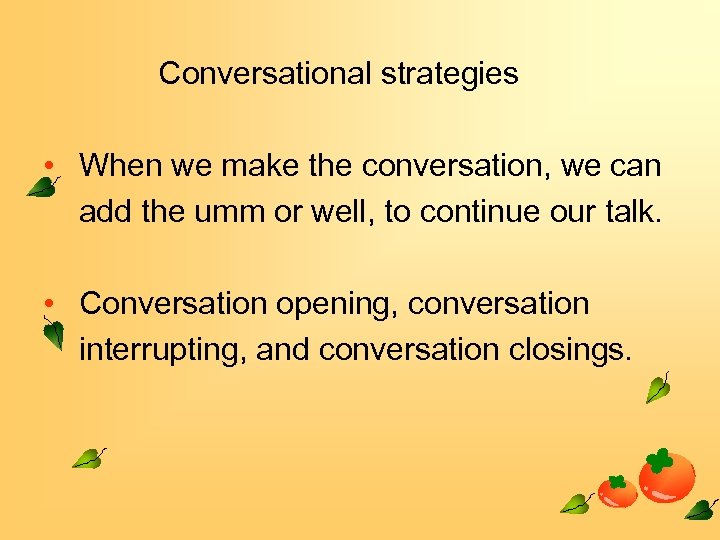 Conversational strategies • When we make the conversation, we can add the umm or well, to continue our talk. • Conversation opening, conversation interrupting, and conversation closings.
Conversational strategies • When we make the conversation, we can add the umm or well, to continue our talk. • Conversation opening, conversation interrupting, and conversation closings.
 Survival and repair strategies • Using certain way to ask question (e. g. how should I say? how should I put it? ) • Formulaic expressions, just like the paraphrase (it’s a kind of…. ). All-purpose phrase, for example: what the word for something you play a guitar with? The answer is “Plectrum”.
Survival and repair strategies • Using certain way to ask question (e. g. how should I say? how should I put it? ) • Formulaic expressions, just like the paraphrase (it’s a kind of…. ). All-purpose phrase, for example: what the word for something you play a guitar with? The answer is “Plectrum”.
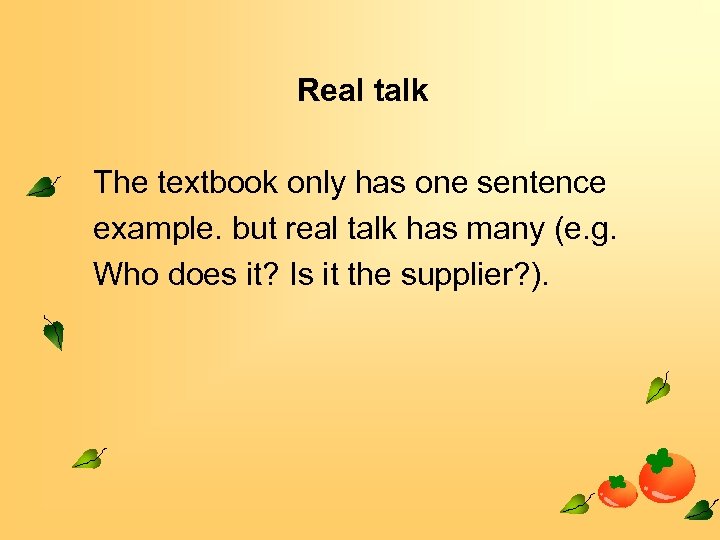 Real talk The textbook only has one sentence example. but real talk has many (e. g. Who does it? Is it the supplier? ).
Real talk The textbook only has one sentence example. but real talk has many (e. g. Who does it? Is it the supplier? ).
 Speaking strategies • To supply more important phrases. • To analysis transcripts of real speech, • directing their attention to how the speaker ask questions, • respond to the questions of the others, and etc.
Speaking strategies • To supply more important phrases. • To analysis transcripts of real speech, • directing their attention to how the speaker ask questions, • respond to the questions of the others, and etc.
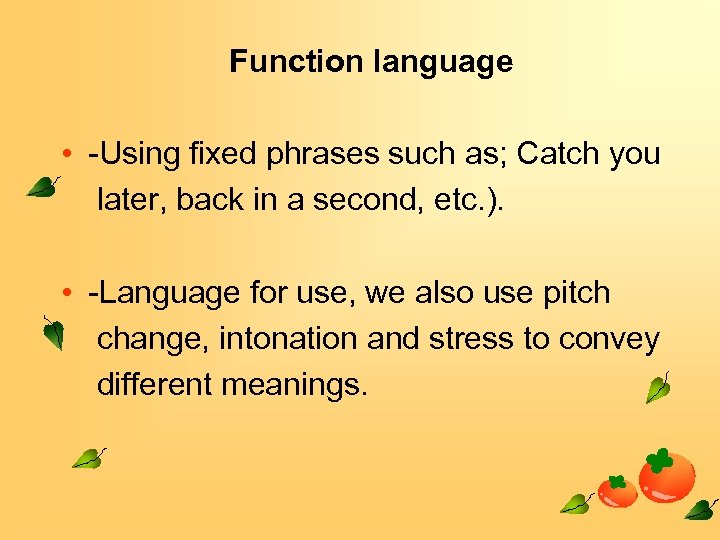 Function language • -Using fixed phrases such as; Catch you later, back in a second, etc. ). • -Language for use, we also use pitch change, intonation and stress to convey different meanings.
Function language • -Using fixed phrases such as; Catch you later, back in a second, etc. ). • -Language for use, we also use pitch change, intonation and stress to convey different meanings.
 Adjacency pairs It’s similar to tag question, for example it’s beautiful, isn’t it? Or you like me, don’t you?
Adjacency pairs It’s similar to tag question, for example it’s beautiful, isn’t it? Or you like me, don’t you?
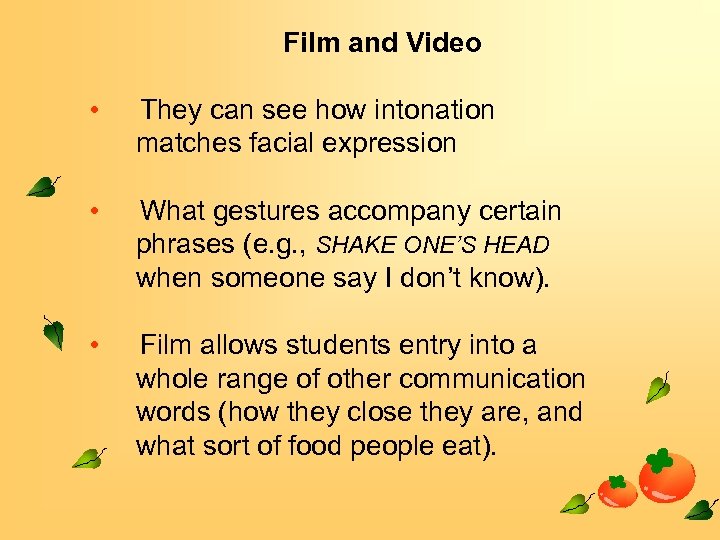 Film and Video • They can see how intonation matches facial expression • What gestures accompany certain phrases (e. g. , SHAKE ONE’S HEAD when someone say I don’t know). • Film allows students entry into a whole range of other communication words (how they close they are, and what sort of food people eat).
Film and Video • They can see how intonation matches facial expression • What gestures accompany certain phrases (e. g. , SHAKE ONE’S HEAD when someone say I don’t know). • Film allows students entry into a whole range of other communication words (how they close they are, and what sort of food people eat).
 Students and speaking • • Good atmosphere class Get on each other well Learner with an appropriate level Participate freely and enthusiastic
Students and speaking • • Good atmosphere class Get on each other well Learner with an appropriate level Participate freely and enthusiastic
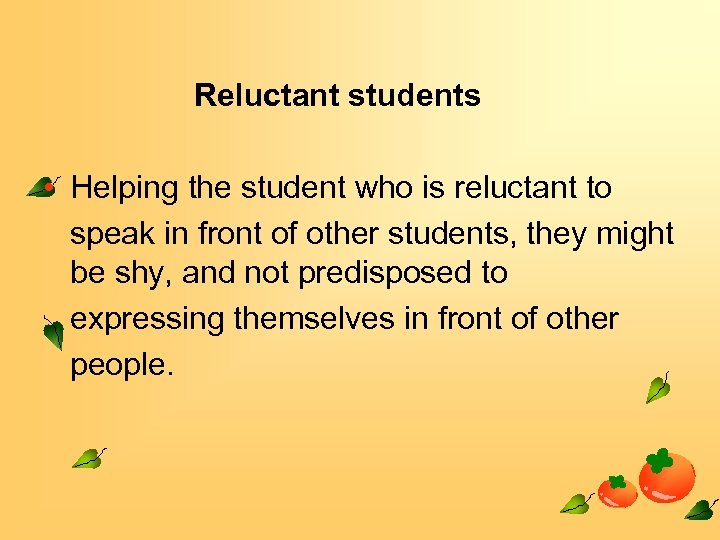 Reluctant students • Helping the student who is reluctant to speak in front of other students, they might be shy, and not predisposed to expressing themselves in front of other people.
Reluctant students • Helping the student who is reluctant to speak in front of other students, they might be shy, and not predisposed to expressing themselves in front of other people.
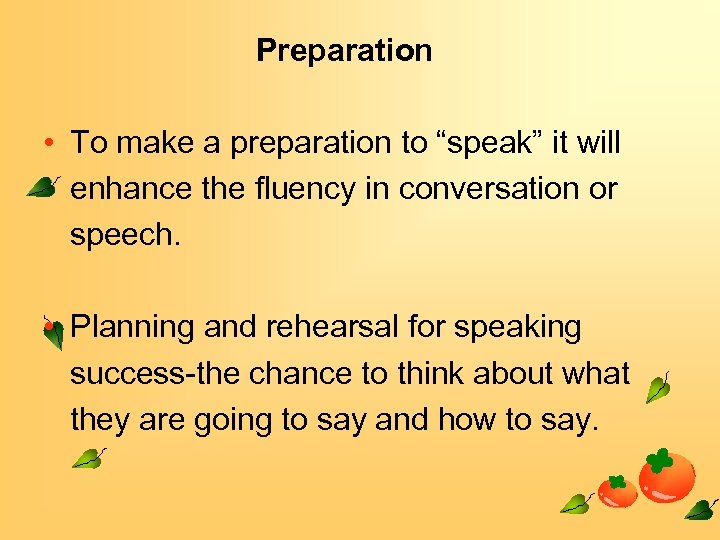 Preparation • To make a preparation to “speak” it will enhance the fluency in conversation or speech. • Planning and rehearsal for speaking success-the chance to think about what they are going to say and how to say.
Preparation • To make a preparation to “speak” it will enhance the fluency in conversation or speech. • Planning and rehearsal for speaking success-the chance to think about what they are going to say and how to say.
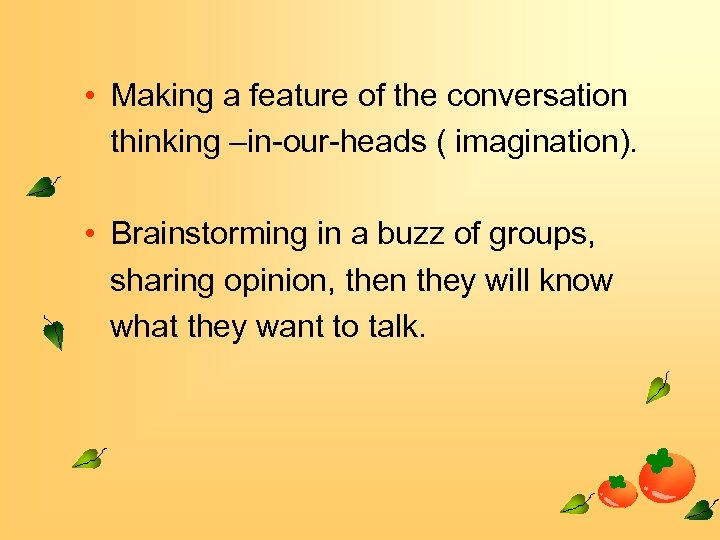 • Making a feature of the conversation thinking –in-our-heads ( imagination). • Brainstorming in a buzz of groups, sharing opinion, then they will know what they want to talk.
• Making a feature of the conversation thinking –in-our-heads ( imagination). • Brainstorming in a buzz of groups, sharing opinion, then they will know what they want to talk.
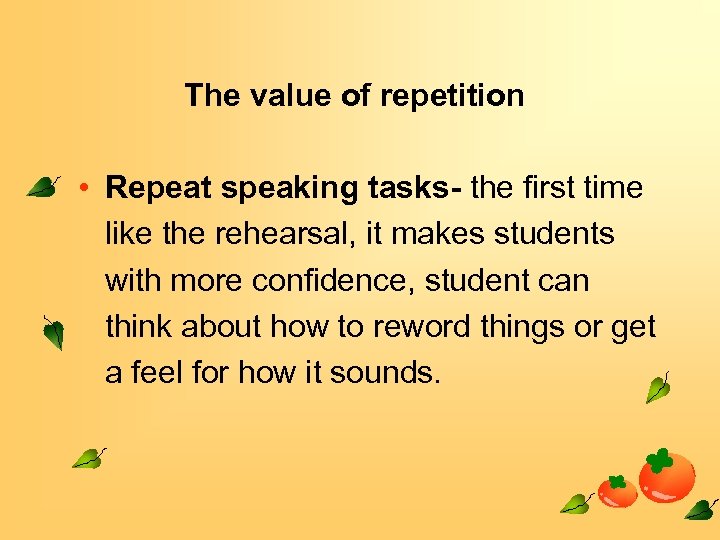 The value of repetition • Repeat speaking tasks- the first time like the rehearsal, it makes students with more confidence, student can think about how to reword things or get a feel for how it sounds.
The value of repetition • Repeat speaking tasks- the first time like the rehearsal, it makes students with more confidence, student can think about how to reword things or get a feel for how it sounds.
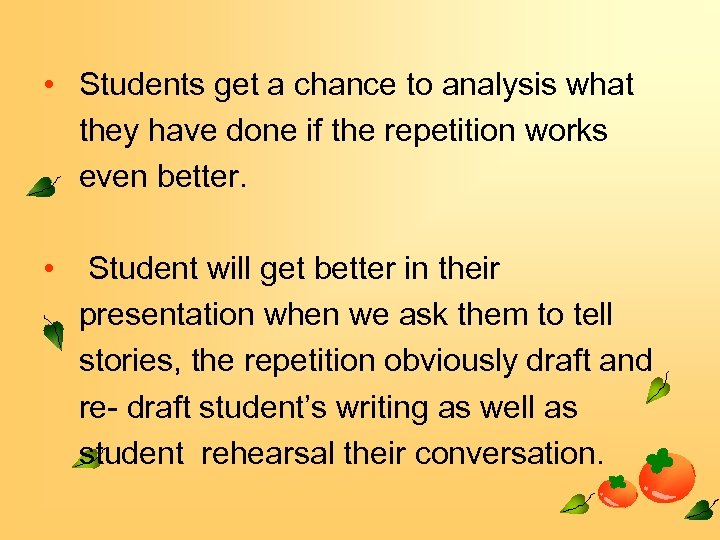 • Students get a chance to analysis what they have done if the repetition works even better. • Student will get better in their presentation when we ask them to tell stories, the repetition obviously draft and re- draft student’s writing as well as student rehearsal their conversation.
• Students get a chance to analysis what they have done if the repetition works even better. • Student will get better in their presentation when we ask them to tell stories, the repetition obviously draft and re- draft student’s writing as well as student rehearsal their conversation.
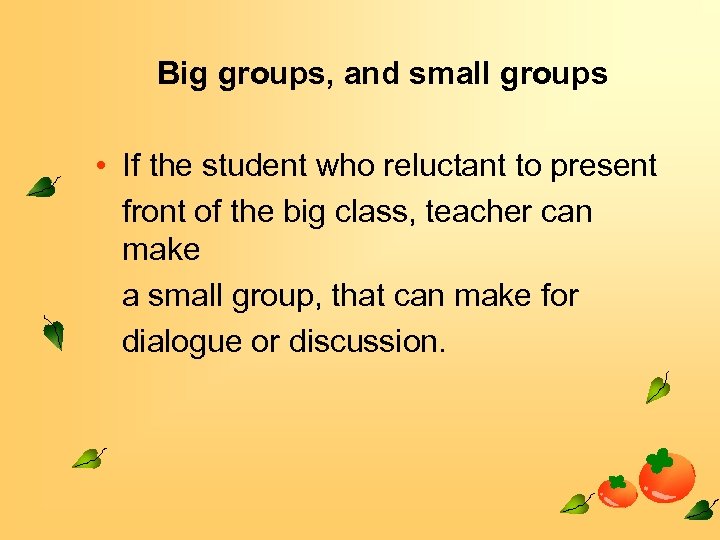 Big groups, and small groups • If the student who reluctant to present front of the big class, teacher can make a small group, that can make for dialogue or discussion.
Big groups, and small groups • If the student who reluctant to present front of the big class, teacher can make a small group, that can make for dialogue or discussion.
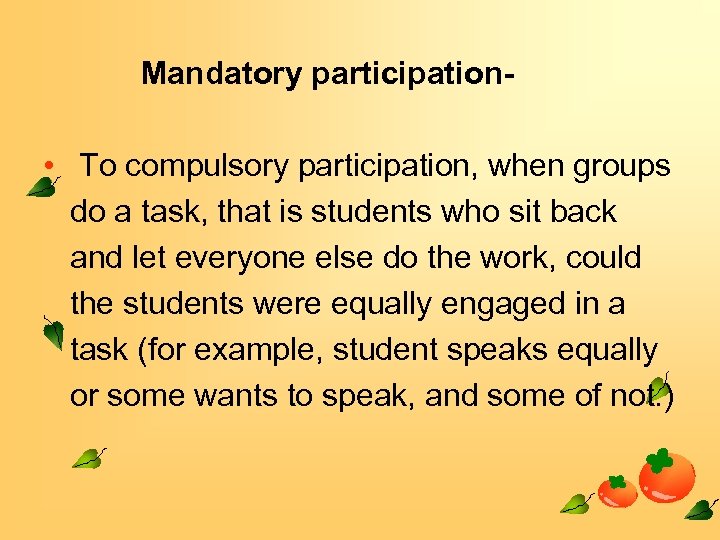 Mandatory participation- • To compulsory participation, when groups do a task, that is students who sit back and let everyone else do the work, could the students were equally engaged in a task (for example, student speaks equally or some wants to speak, and some of not. )
Mandatory participation- • To compulsory participation, when groups do a task, that is students who sit back and let everyone else do the work, could the students were equally engaged in a task (for example, student speaks equally or some wants to speak, and some of not. )
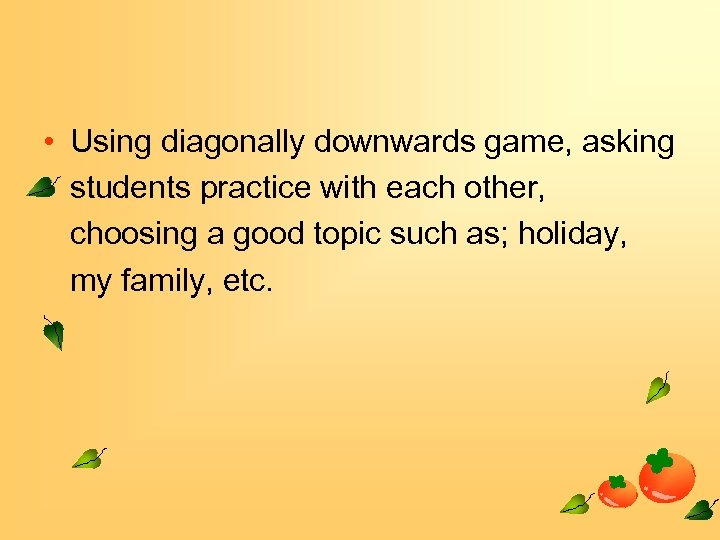 • Using diagonally downwards game, asking students practice with each other, choosing a good topic such as; holiday, my family, etc.
• Using diagonally downwards game, asking students practice with each other, choosing a good topic such as; holiday, my family, etc.
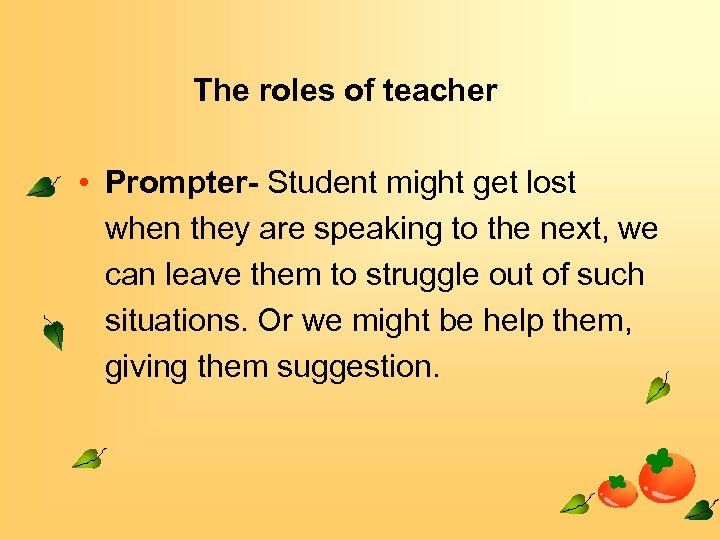 The roles of teacher • Prompter- Student might get lost when they are speaking to the next, we can leave them to struggle out of such situations. Or we might be help them, giving them suggestion.
The roles of teacher • Prompter- Student might get lost when they are speaking to the next, we can leave them to struggle out of such situations. Or we might be help them, giving them suggestion.
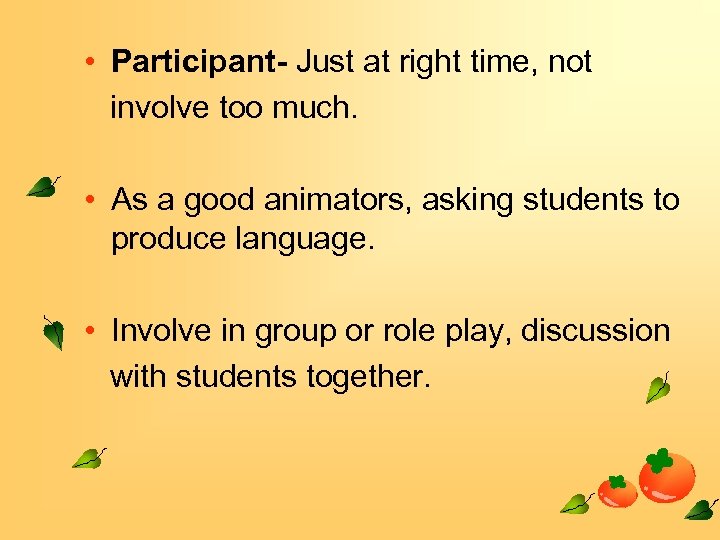 • Participant- Just at right time, not involve too much. • As a good animators, asking students to produce language. • Involve in group or role play, discussion with students together.
• Participant- Just at right time, not involve too much. • As a good animators, asking students to produce language. • Involve in group or role play, discussion with students together.
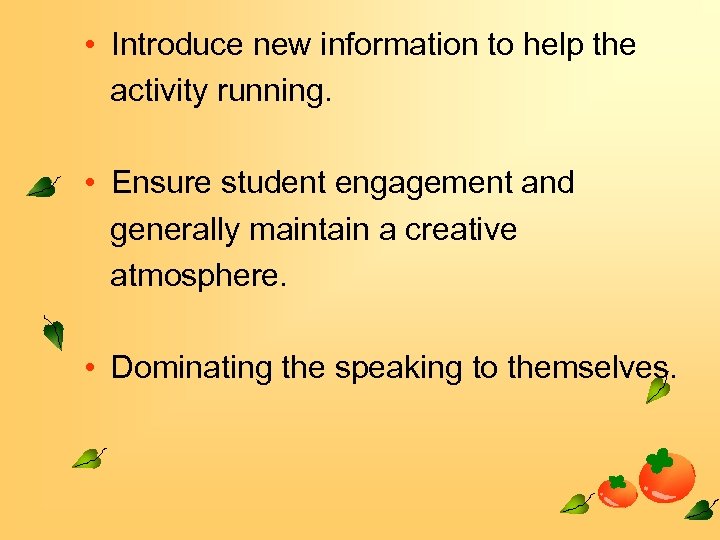 • Introduce new information to help the activity running. • Ensure student engagement and generally maintain a creative atmosphere. • Dominating the speaking to themselves.
• Introduce new information to help the activity running. • Ensure student engagement and generally maintain a creative atmosphere. • Dominating the speaking to themselves.
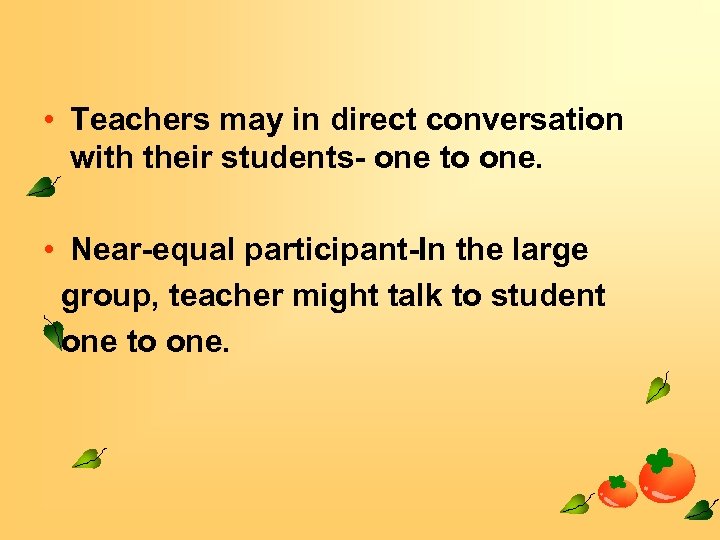 • Teachers may in direct conversation with their students- one to one. • Near-equal participant-In the large group, teacher might talk to student one to one.
• Teachers may in direct conversation with their students- one to one. • Near-equal participant-In the large group, teacher might talk to student one to one.
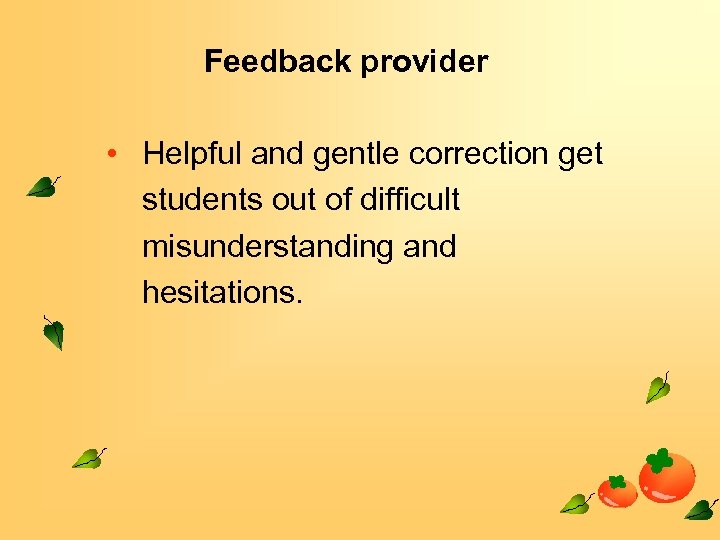 Feedback provider • Helpful and gentle correction get students out of difficult misunderstanding and hesitations.
Feedback provider • Helpful and gentle correction get students out of difficult misunderstanding and hesitations.
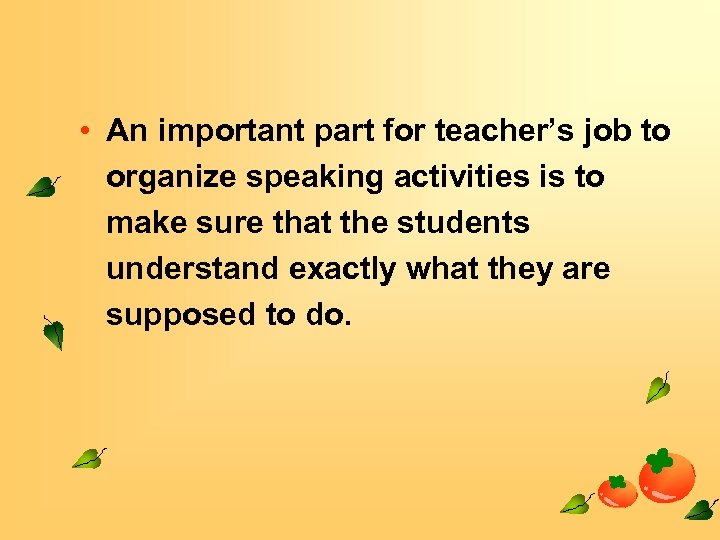 • An important part for teacher’s job to organize speaking activities is to make sure that the students understand exactly what they are supposed to do.
• An important part for teacher’s job to organize speaking activities is to make sure that the students understand exactly what they are supposed to do.
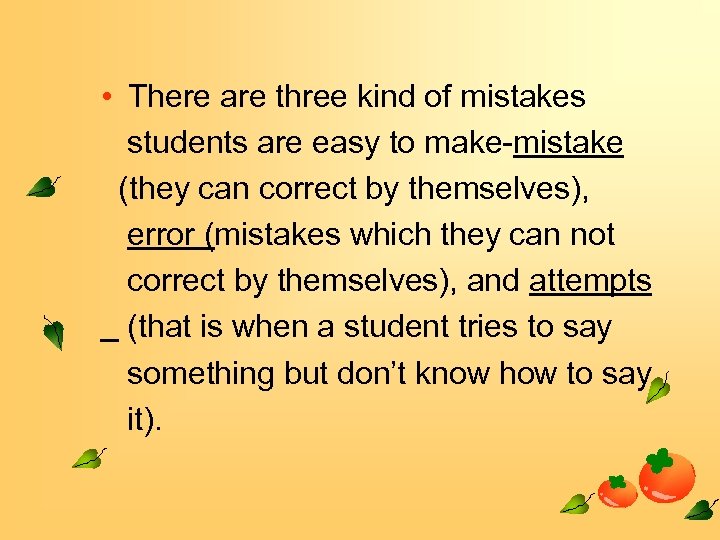 • There are three kind of mistakes students are easy to make-mistake (they can correct by themselves), error (mistakes which they can not correct by themselves), and attempts (that is when a student tries to say something but don’t know how to say it).
• There are three kind of mistakes students are easy to make-mistake (they can correct by themselves), error (mistakes which they can not correct by themselves), and attempts (that is when a student tries to say something but don’t know how to say it).
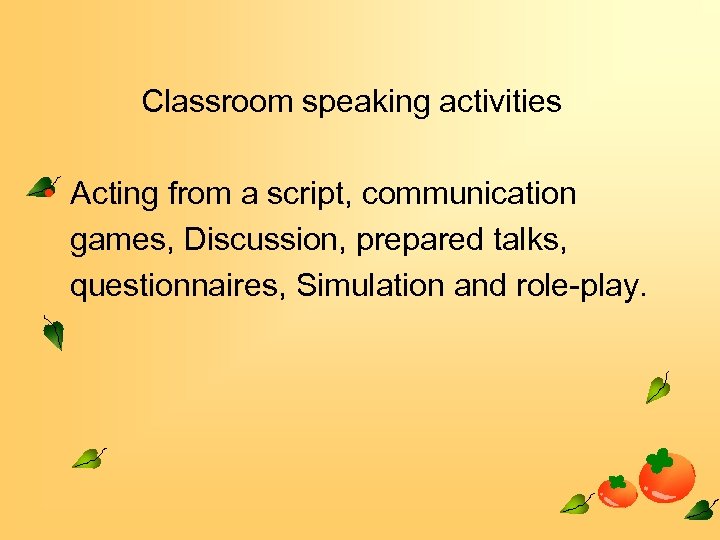 Classroom speaking activities • Acting from a script, communication games, Discussion, prepared talks, questionnaires, Simulation and role-play.
Classroom speaking activities • Acting from a script, communication games, Discussion, prepared talks, questionnaires, Simulation and role-play.
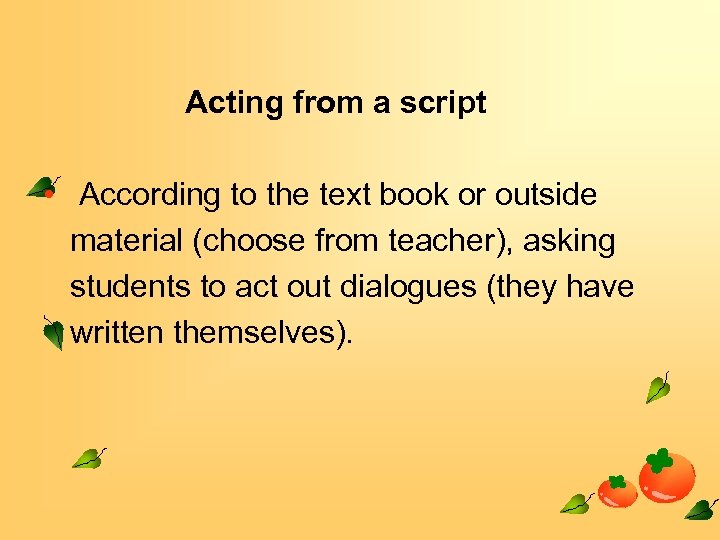 Acting from a script • According to the text book or outside material (choose from teacher), asking students to act out dialogues (they have written themselves).
Acting from a script • According to the text book or outside material (choose from teacher), asking students to act out dialogues (they have written themselves).
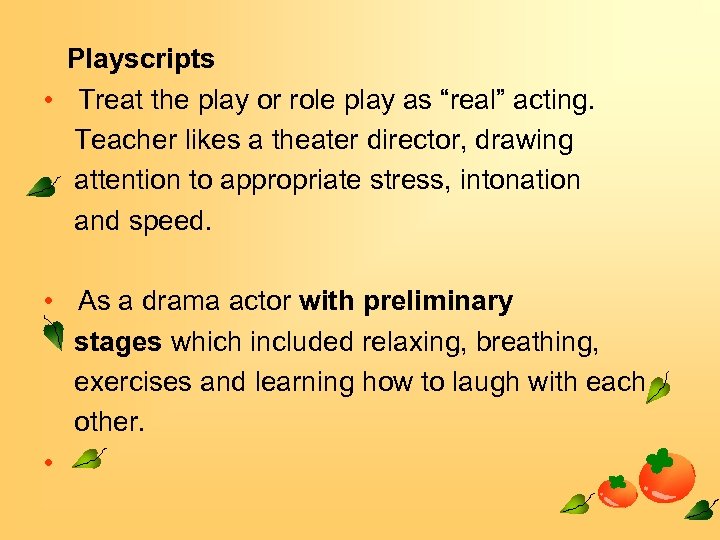 Playscripts • Treat the play or role play as “real” acting. Teacher likes a theater director, drawing attention to appropriate stress, intonation and speed. • As a drama actor with preliminary stages which included relaxing, breathing, exercises and learning how to laugh with each other. •
Playscripts • Treat the play or role play as “real” acting. Teacher likes a theater director, drawing attention to appropriate stress, intonation and speed. • As a drama actor with preliminary stages which included relaxing, breathing, exercises and learning how to laugh with each other. •
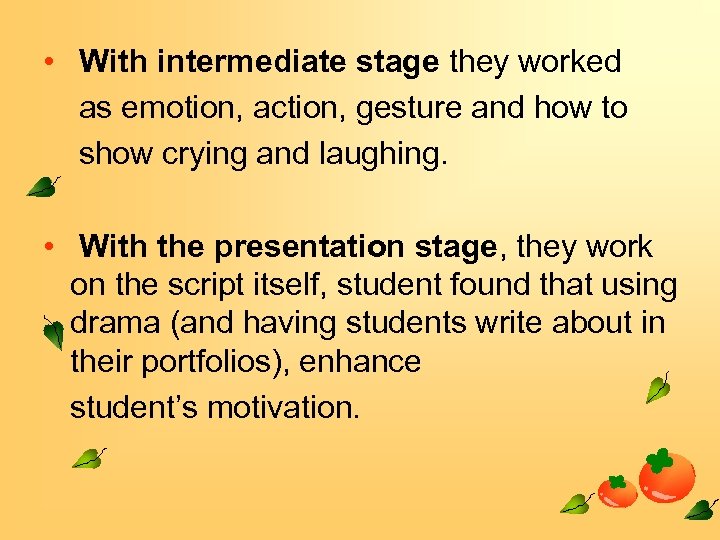 • With intermediate stage they worked as emotion, action, gesture and how to show crying and laughing. • With the presentation stage, they work on the script itself, student found that using drama (and having students write about in their portfolios), enhance student’s motivation.
• With intermediate stage they worked as emotion, action, gesture and how to show crying and laughing. • With the presentation stage, they work on the script itself, student found that using drama (and having students write about in their portfolios), enhance student’s motivation.
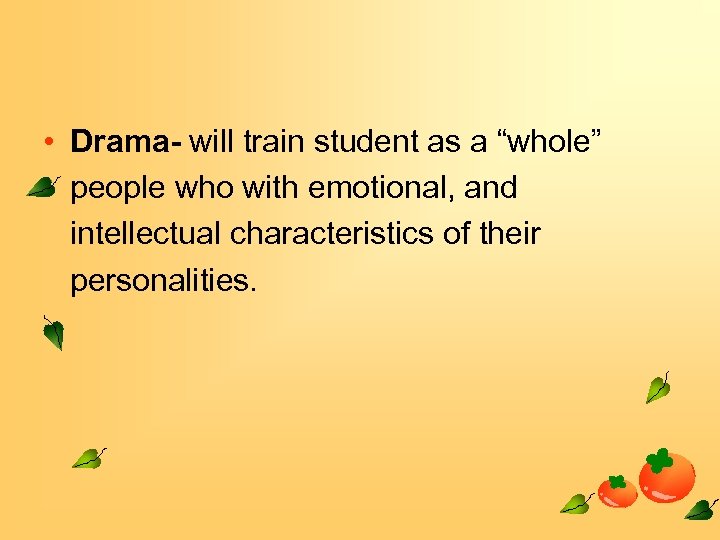 • Drama- will train student as a “whole” people who with emotional, and intellectual characteristics of their personalities.
• Drama- will train student as a “whole” people who with emotional, and intellectual characteristics of their personalities.
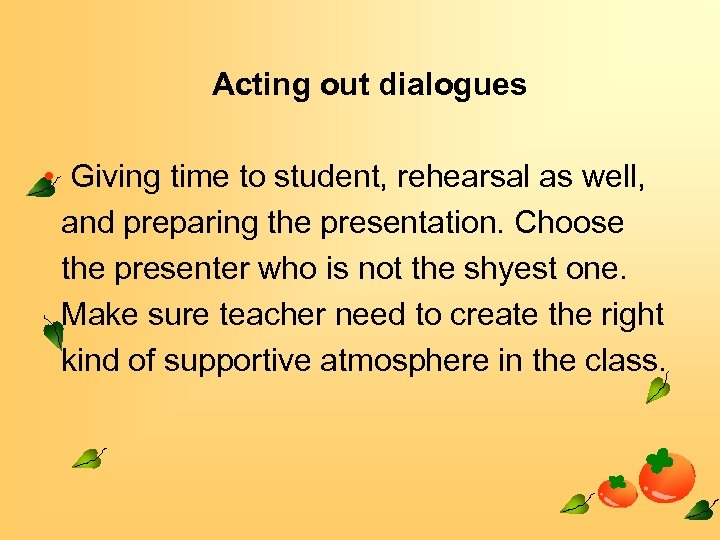 Acting out dialogues • Giving time to student, rehearsal as well, and preparing the presentation. Choose the presenter who is not the shyest one. Make sure teacher need to create the right kind of supportive atmosphere in the class.
Acting out dialogues • Giving time to student, rehearsal as well, and preparing the presentation. Choose the presenter who is not the shyest one. Make sure teacher need to create the right kind of supportive atmosphere in the class.
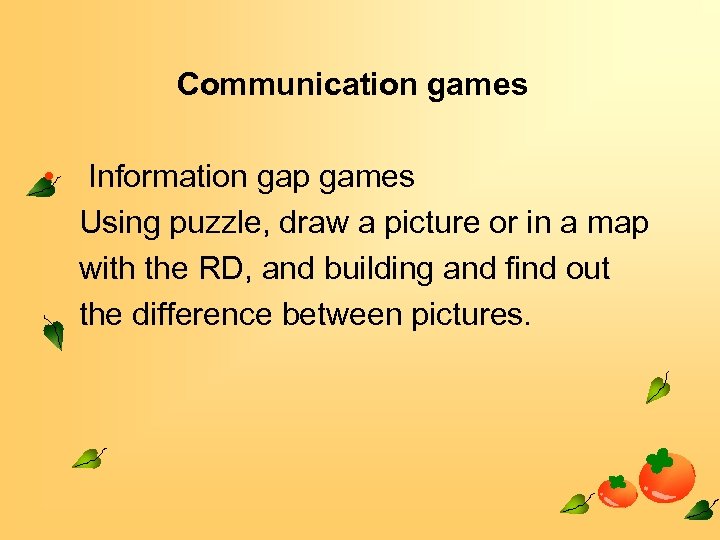 Communication games • Information gap games Using puzzle, draw a picture or in a map with the RD, and building and find out the difference between pictures.
Communication games • Information gap games Using puzzle, draw a picture or in a map with the RD, and building and find out the difference between pictures.
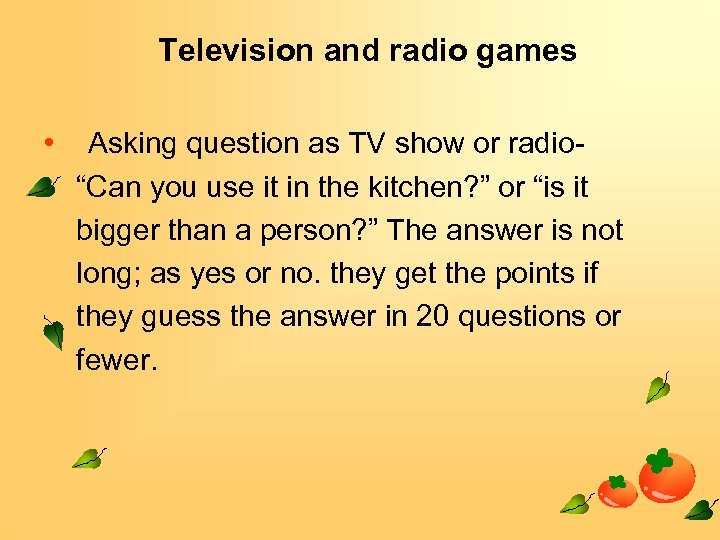 Television and radio games • Asking question as TV show or radio“Can you use it in the kitchen? ” or “is it bigger than a person? ” The answer is not long; as yes or no. they get the points if they guess the answer in 20 questions or fewer.
Television and radio games • Asking question as TV show or radio“Can you use it in the kitchen? ” or “is it bigger than a person? ” The answer is not long; as yes or no. they get the points if they guess the answer in 20 questions or fewer.
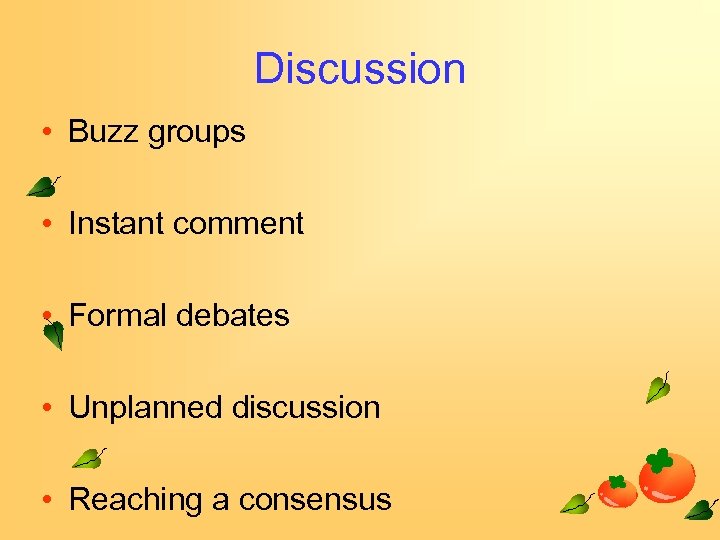 Discussion • Buzz groups • Instant comment • Formal debates • Unplanned discussion • Reaching a consensus
Discussion • Buzz groups • Instant comment • Formal debates • Unplanned discussion • Reaching a consensus
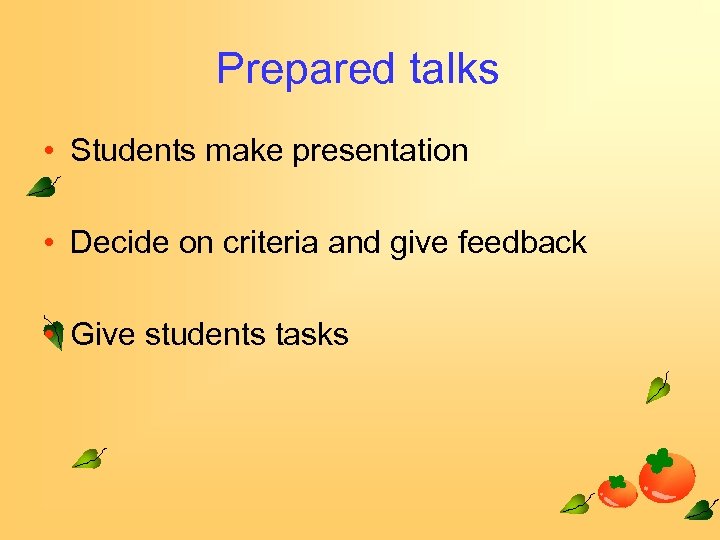 Prepared talks • Students make presentation • Decide on criteria and give feedback • Give students tasks
Prepared talks • Students make presentation • Decide on criteria and give feedback • Give students tasks
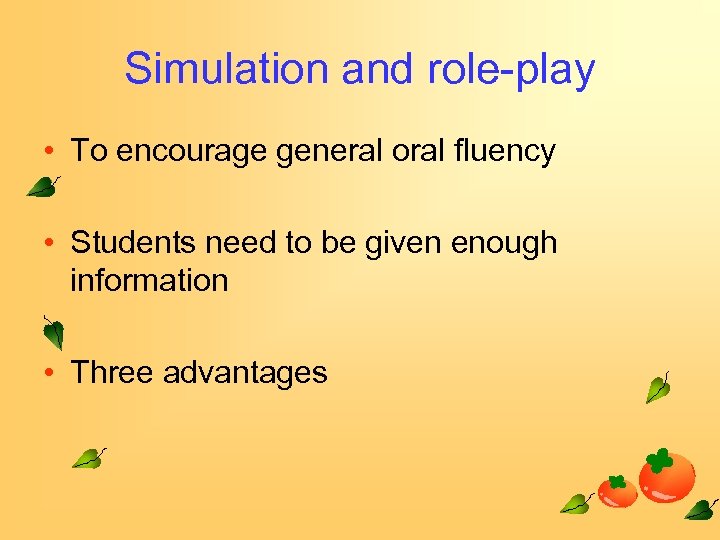 Simulation and role-play • To encourage general oral fluency • Students need to be given enough information • Three advantages
Simulation and role-play • To encourage general oral fluency • Students need to be given enough information • Three advantages
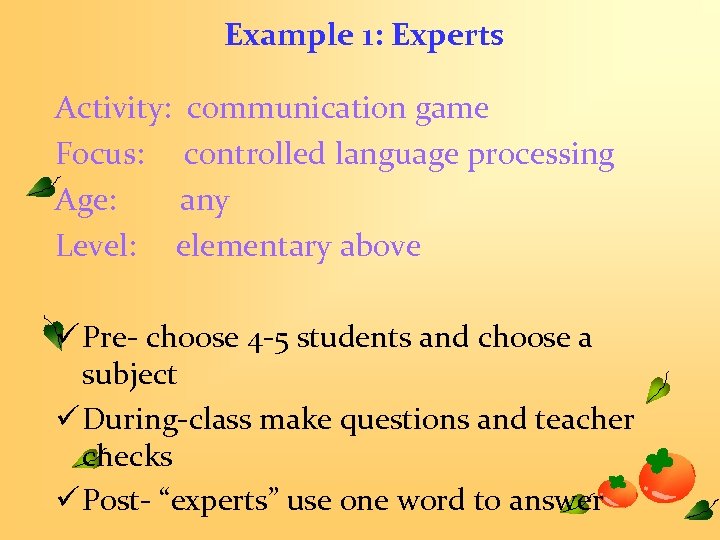 Example 1: Experts Activity: communication game Focus: controlled language processing Age: any Level: elementary above ü Pre- choose 4 -5 students and choose a subject ü During-class make questions and teacher checks ü Post- “experts” use one word to answer
Example 1: Experts Activity: communication game Focus: controlled language processing Age: any Level: elementary above ü Pre- choose 4 -5 students and choose a subject ü During-class make questions and teacher checks ü Post- “experts” use one word to answer
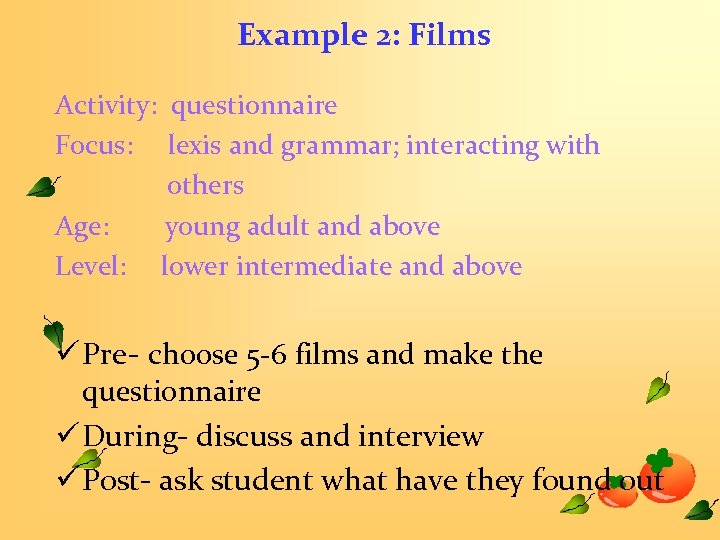 Example 2: Films Activity: questionnaire Focus: lexis and grammar; interacting with others Age: young adult and above Level: lower intermediate and above ü Pre- choose 5 -6 films and make the questionnaire ü During- discuss and interview ü Post- ask student what have they found out
Example 2: Films Activity: questionnaire Focus: lexis and grammar; interacting with others Age: young adult and above Level: lower intermediate and above ü Pre- choose 5 -6 films and make the questionnaire ü During- discuss and interview ü Post- ask student what have they found out
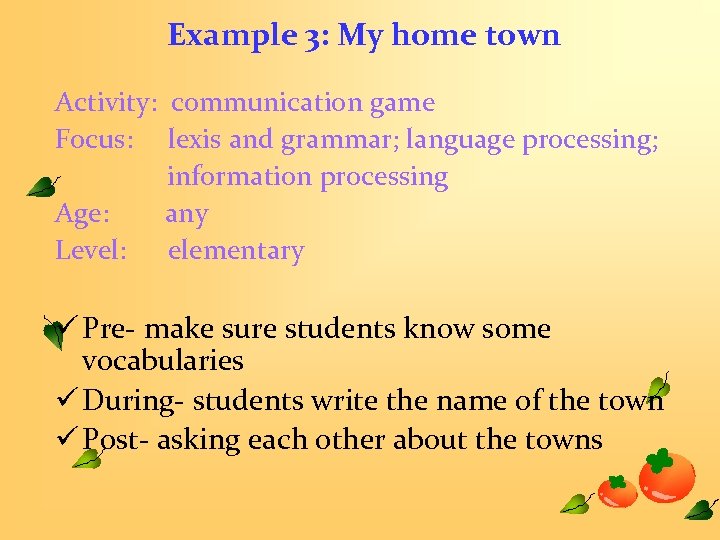 Example 3: My home town Activity: communication game Focus: lexis and grammar; language processing; information processing Age: any Level: elementary ü Pre- make sure students know some vocabularies ü During- students write the name of the town ü Post- asking each other about the towns
Example 3: My home town Activity: communication game Focus: lexis and grammar; language processing; information processing Age: any Level: elementary ü Pre- make sure students know some vocabularies ü During- students write the name of the town ü Post- asking each other about the towns
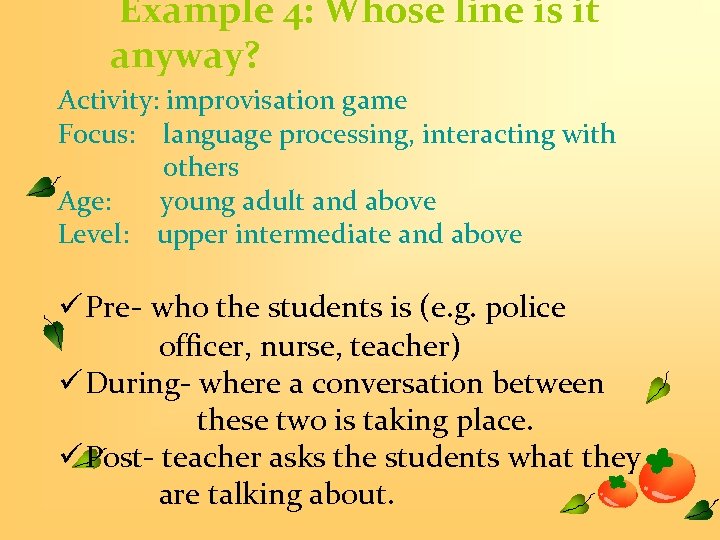 Example 4: Whose line is it anyway? Activity: improvisation game Focus: language processing, interacting with others Age: young adult and above Level: upper intermediate and above ü Pre- who the students is (e. g. police officer, nurse, teacher) ü During- where a conversation between these two is taking place. ü Post- teacher asks the students what they are talking about.
Example 4: Whose line is it anyway? Activity: improvisation game Focus: language processing, interacting with others Age: young adult and above Level: upper intermediate and above ü Pre- who the students is (e. g. police officer, nurse, teacher) ü During- where a conversation between these two is taking place. ü Post- teacher asks the students what they are talking about.
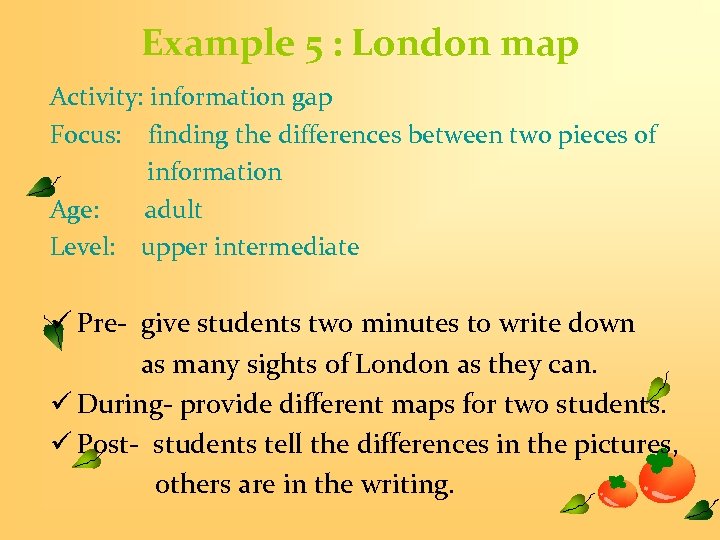 Example 5 : London map Activity: information gap Focus: finding the differences between two pieces of information Age: adult Level: upper intermediate ü Pre- give students two minutes to write down as many sights of London as they can. ü During- provide different maps for two students. ü Post- students tell the differences in the pictures, others are in the writing.
Example 5 : London map Activity: information gap Focus: finding the differences between two pieces of information Age: adult Level: upper intermediate ü Pre- give students two minutes to write down as many sights of London as they can. ü During- provide different maps for two students. ü Post- students tell the differences in the pictures, others are in the writing.
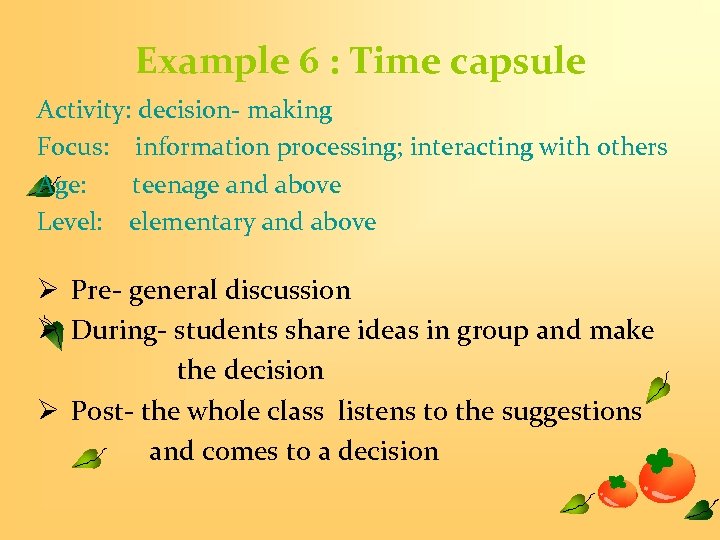 Example 6 : Time capsule Activity: decision- making Focus: information processing; interacting with others Age: teenage and above Level: elementary and above Ø Pre- general discussion Ø During- students share ideas in group and make the decision Ø Post- the whole class listens to the suggestions and comes to a decision
Example 6 : Time capsule Activity: decision- making Focus: information processing; interacting with others Age: teenage and above Level: elementary and above Ø Pre- general discussion Ø During- students share ideas in group and make the decision Ø Post- the whole class listens to the suggestions and comes to a decision
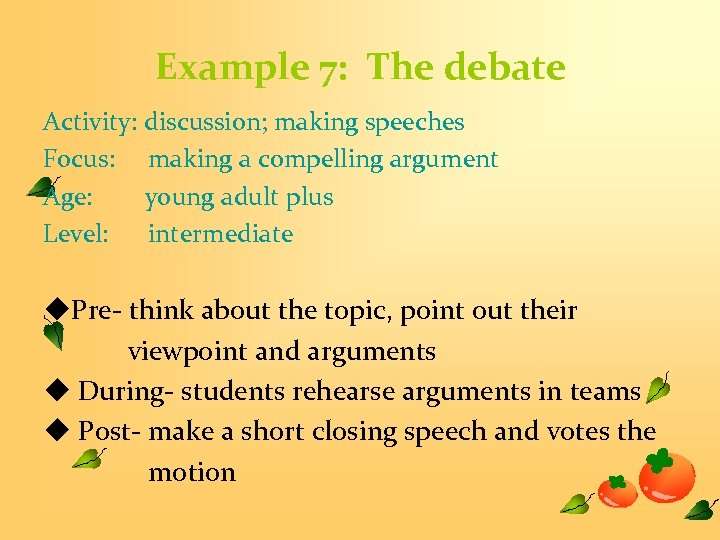 Example 7: The debate Activity: discussion; making speeches Focus: making a compelling argument Age: young adult plus Level: intermediate u. Pre- think about the topic, point out their viewpoint and arguments u During- students rehearse arguments in teams u Post- make a short closing speech and votes the motion
Example 7: The debate Activity: discussion; making speeches Focus: making a compelling argument Age: young adult plus Level: intermediate u. Pre- think about the topic, point out their viewpoint and arguments u During- students rehearse arguments in teams u Post- make a short closing speech and votes the motion
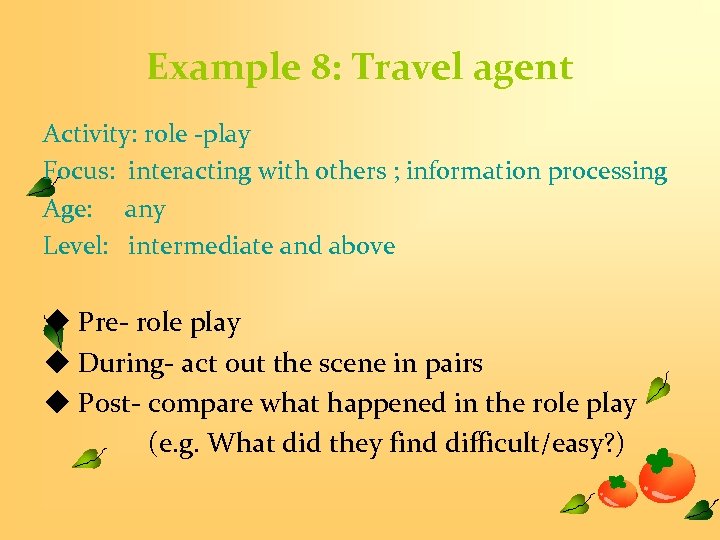 Example 8: Travel agent Activity: role -play Focus: interacting with others ; information processing Age: any Level: intermediate and above u Pre- role play u During- act out the scene in pairs u Post- compare what happened in the role play (e. g. What did they find difficult/easy? )
Example 8: Travel agent Activity: role -play Focus: interacting with others ; information processing Age: any Level: intermediate and above u Pre- role play u During- act out the scene in pairs u Post- compare what happened in the role play (e. g. What did they find difficult/easy? )
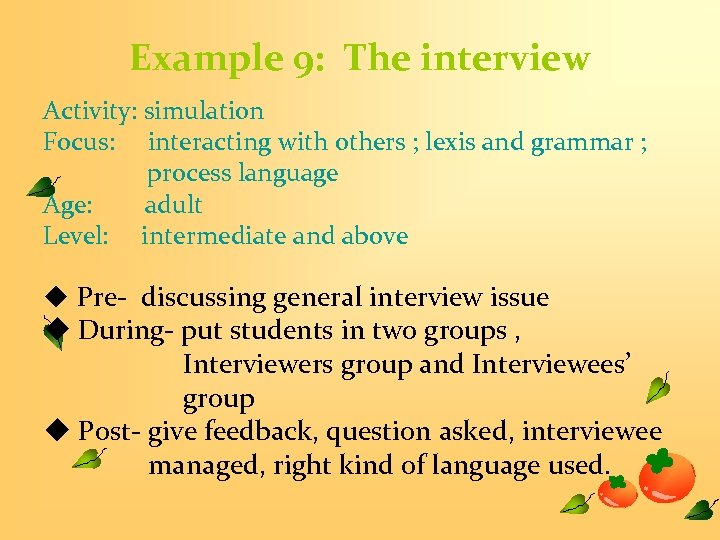 Example 9: The interview Activity: simulation Focus: interacting with others ; lexis and grammar ; process language Age: adult Level: intermediate and above u Pre- discussing general interview issue u During- put students in two groups , Interviewers group and Interviewees’ group u Post- give feedback, question asked, interviewee managed, right kind of language used.
Example 9: The interview Activity: simulation Focus: interacting with others ; lexis and grammar ; process language Age: adult Level: intermediate and above u Pre- discussing general interview issue u During- put students in two groups , Interviewers group and Interviewees’ group u Post- give feedback, question asked, interviewee managed, right kind of language used.
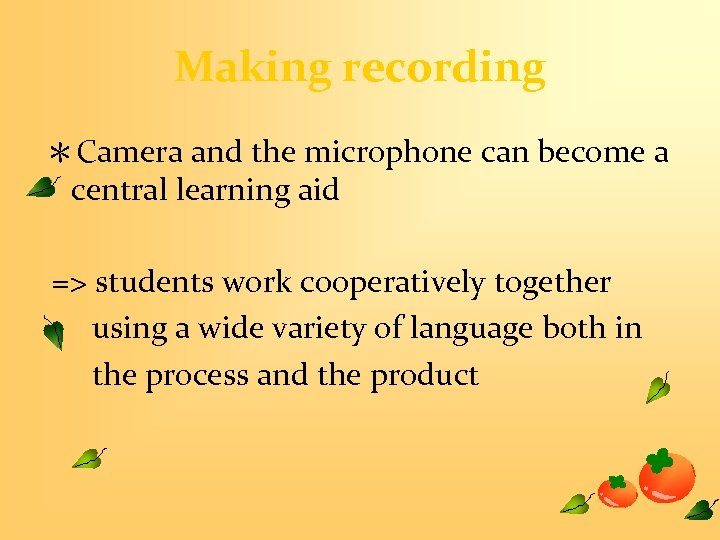 Making recording *Camera and the microphone can become a central learning aid => students work cooperatively together using a wide variety of language both in the process and the product
Making recording *Camera and the microphone can become a central learning aid => students work cooperatively together using a wide variety of language both in the process and the product
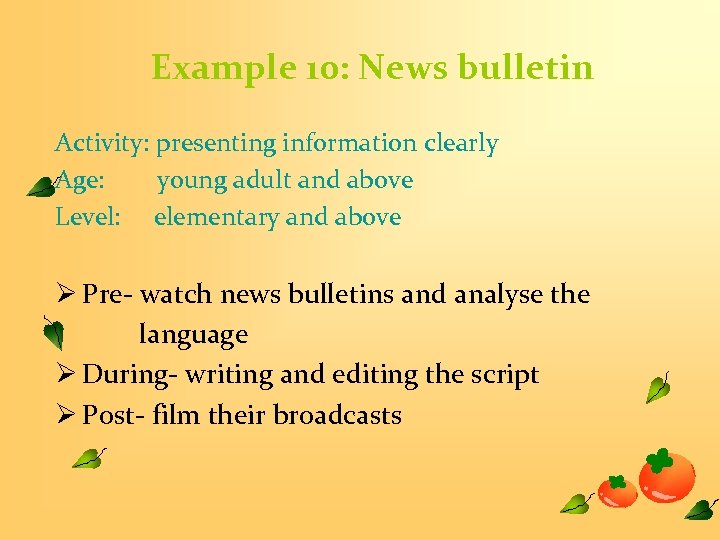 Example 10: News bulletin Activity: presenting information clearly Age: young adult and above Level: elementary and above Ø Pre- watch news bulletins and analyse the language Ø During- writing and editing the script Ø Post- film their broadcasts
Example 10: News bulletin Activity: presenting information clearly Age: young adult and above Level: elementary and above Ø Pre- watch news bulletins and analyse the language Ø During- writing and editing the script Ø Post- film their broadcasts
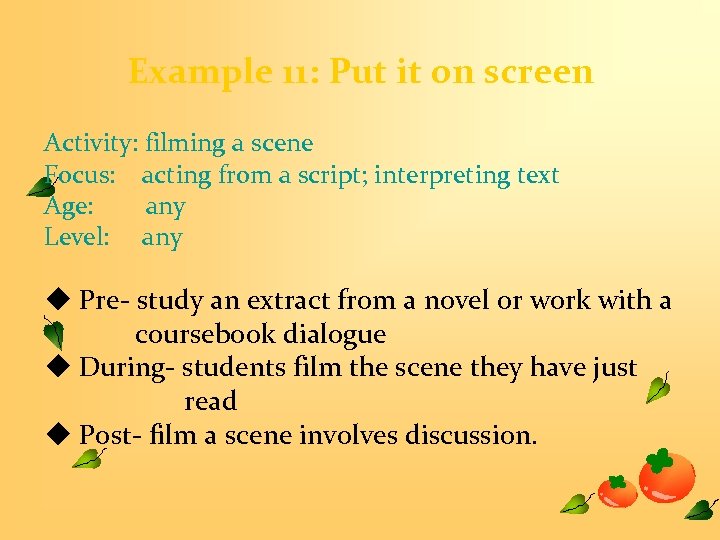 Example 11: Put it on screen Activity: filming a scene Focus: acting from a script; interpreting text Age: any Level: any u Pre- study an extract from a novel or work with a coursebook dialogue u During- students film the scene they have just read u Post- film a scene involves discussion.
Example 11: Put it on screen Activity: filming a scene Focus: acting from a script; interpreting text Age: any Level: any u Pre- study an extract from a novel or work with a coursebook dialogue u During- students film the scene they have just read u Post- film a scene involves discussion.
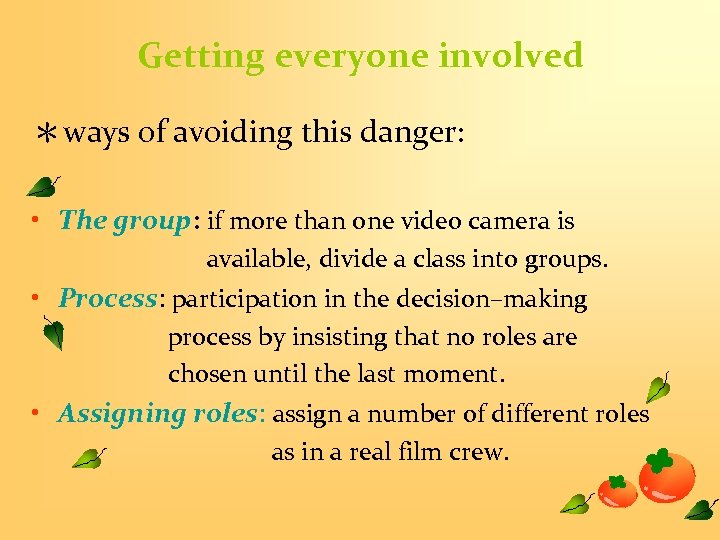 Getting everyone involved *ways of avoiding this danger: • The group: if more than one video camera is available, divide a class into groups. • Process: participation in the decision–making process by insisting that no roles are chosen until the last moment. • Assigning roles: assign a number of different roles as in a real film crew.
Getting everyone involved *ways of avoiding this danger: • The group: if more than one video camera is available, divide a class into groups. • Process: participation in the decision–making process by insisting that no roles are chosen until the last moment. • Assigning roles: assign a number of different roles as in a real film crew.
 Thank you for your listening
Thank you for your listening


